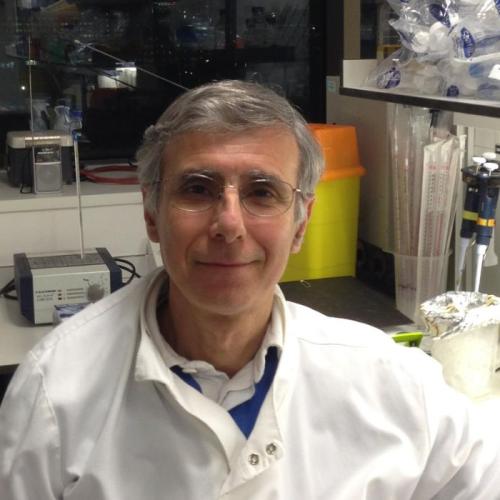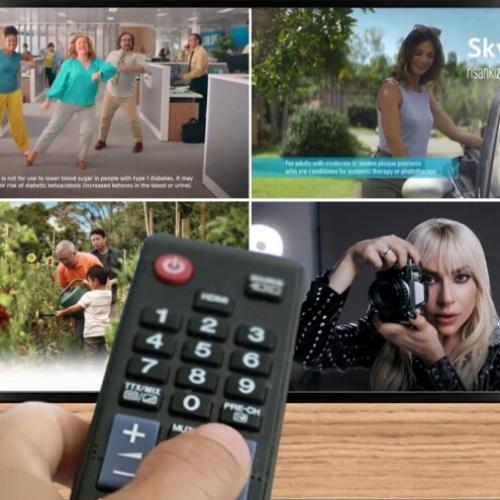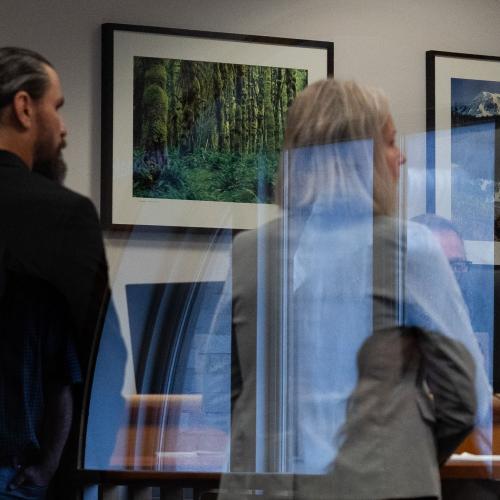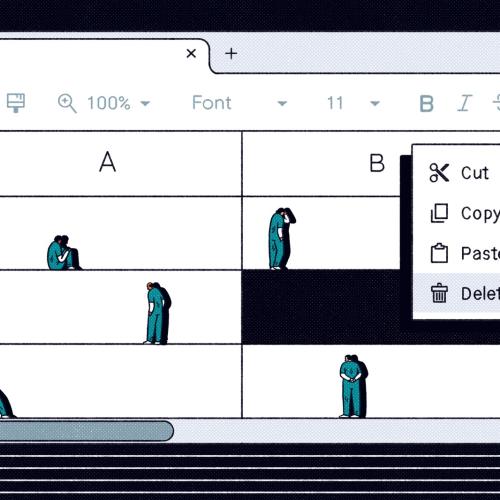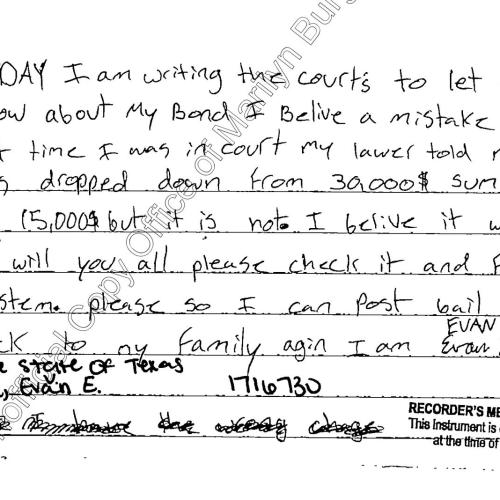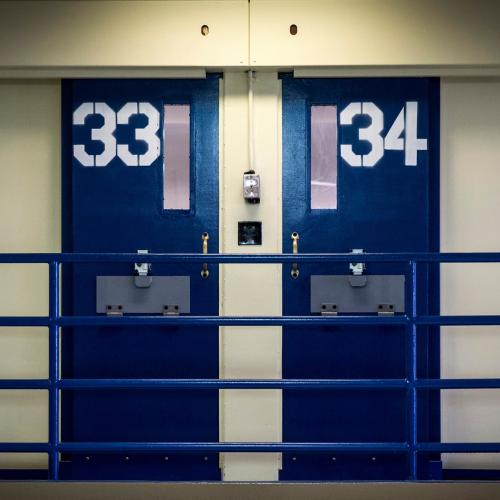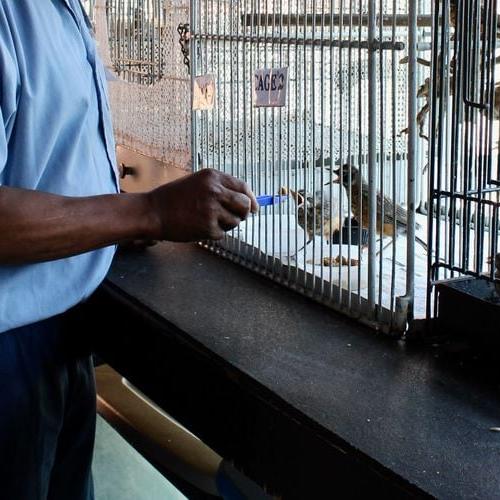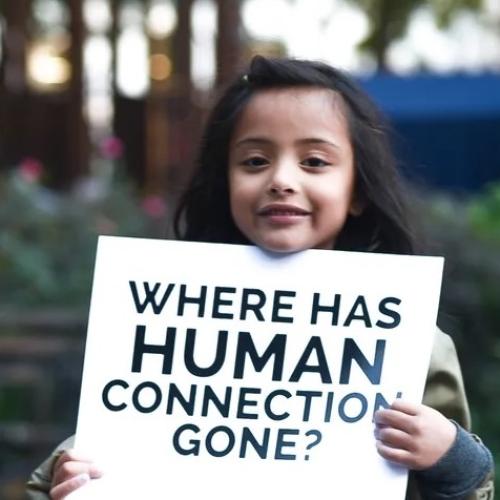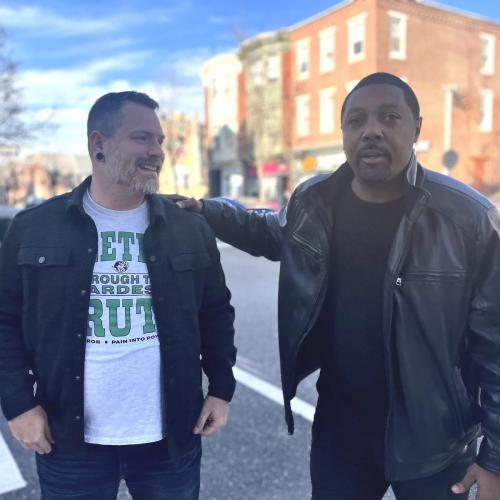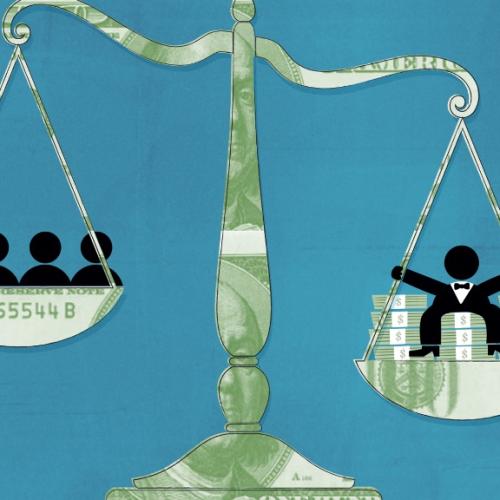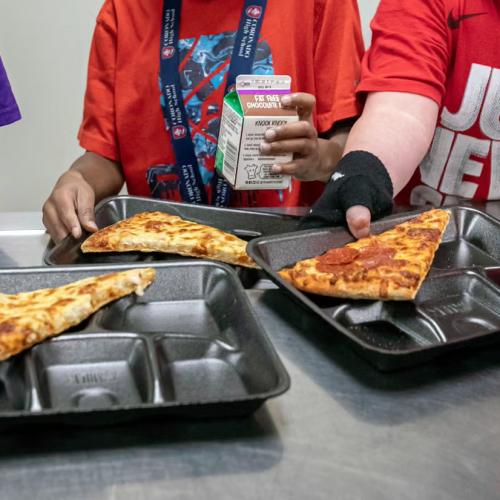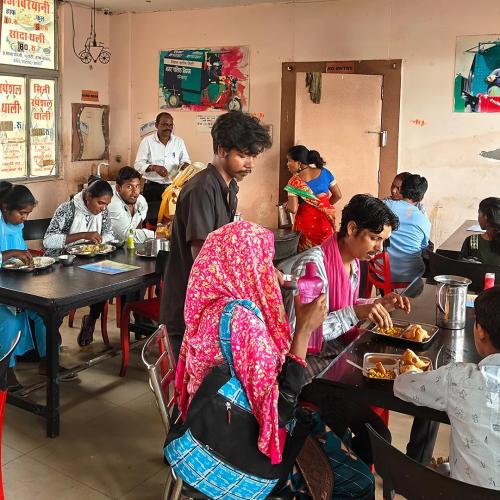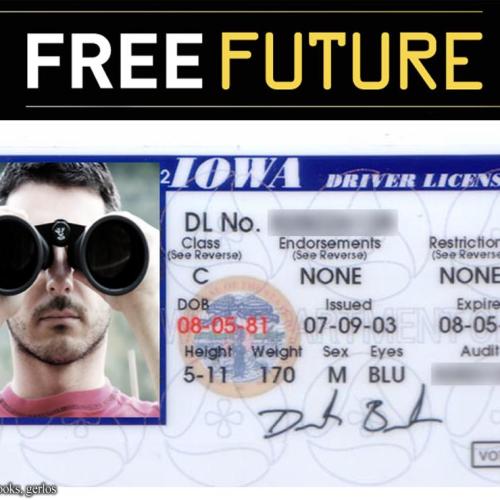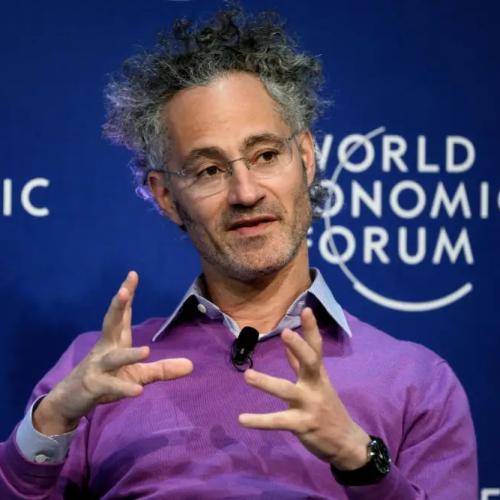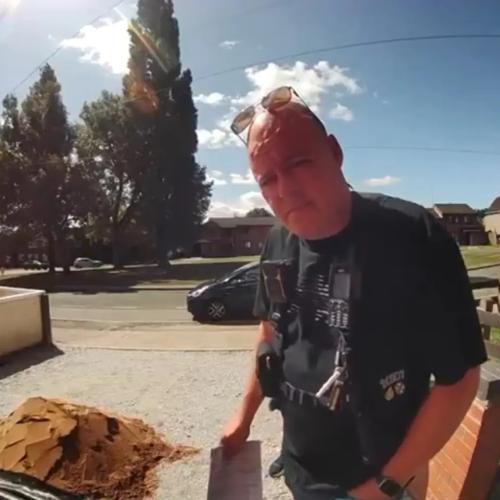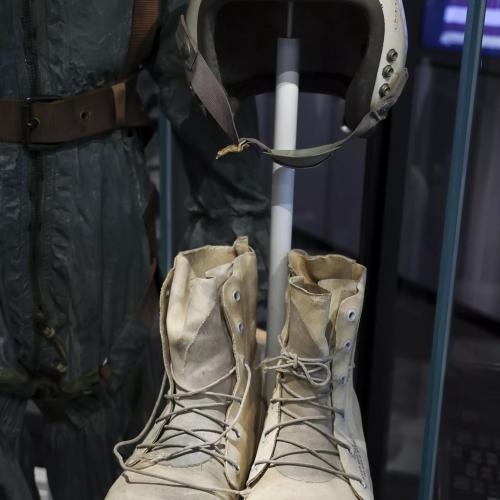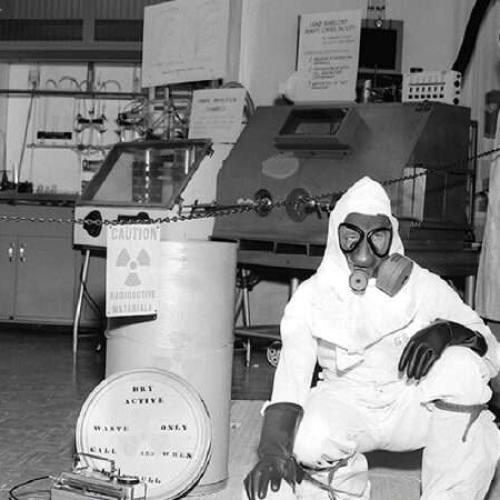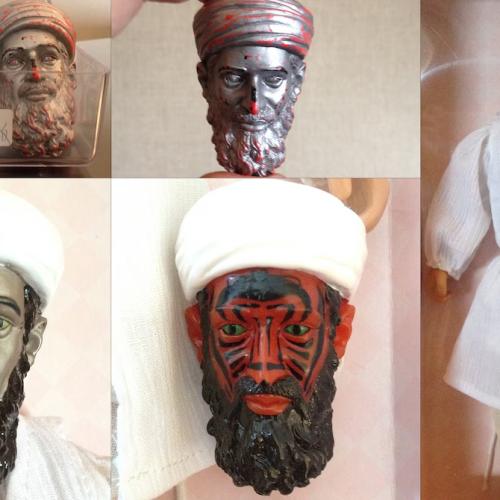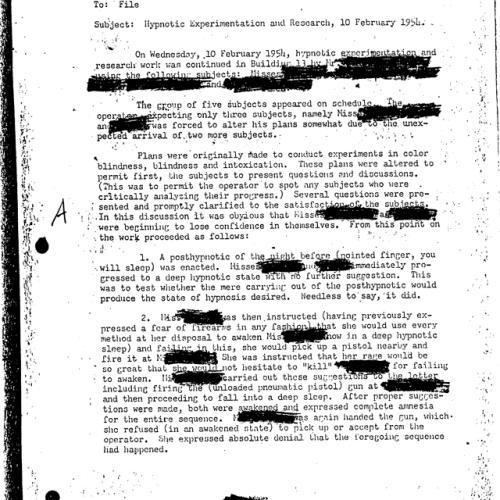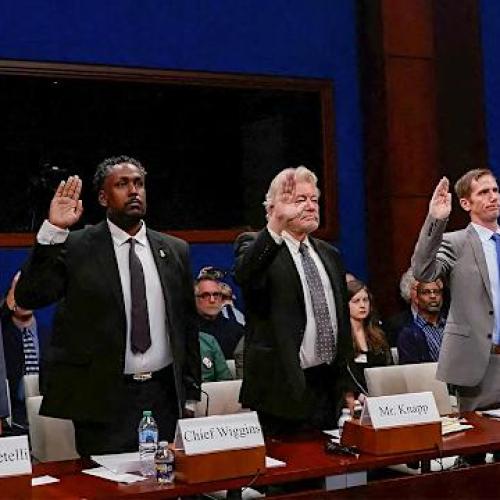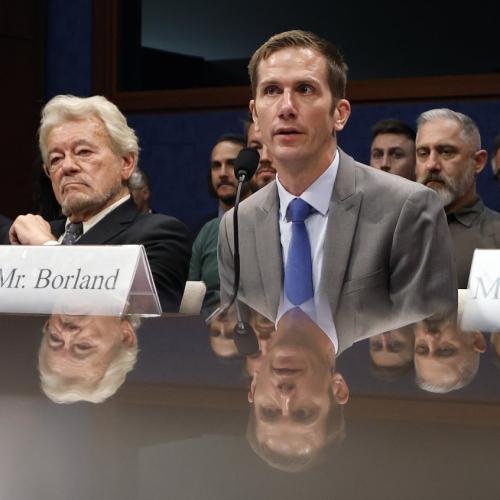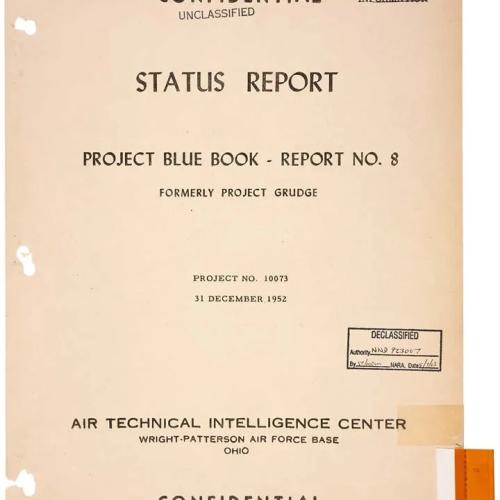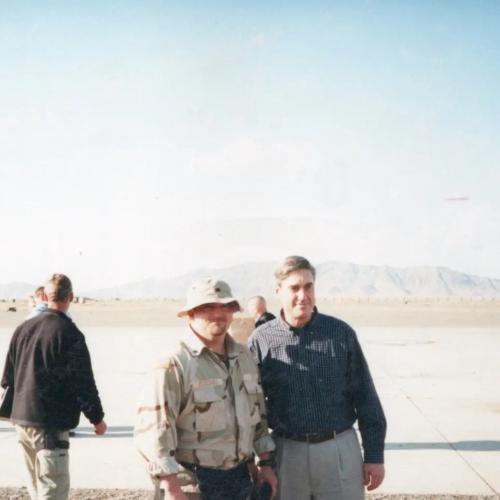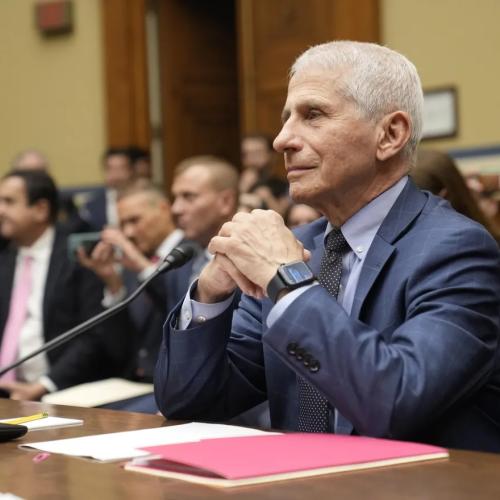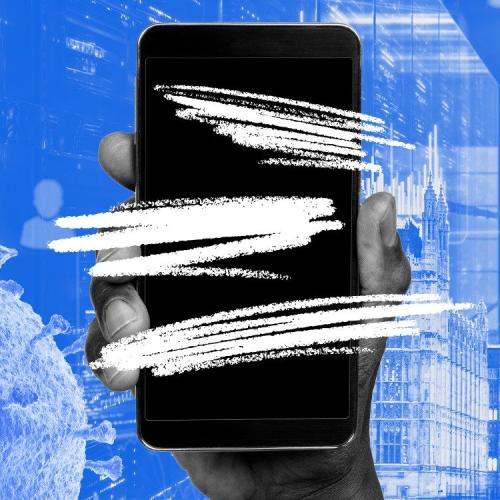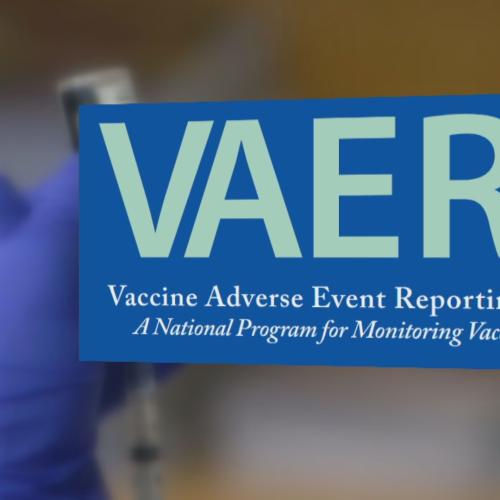Inspiring: People with Disabilities News Articles
Below are key excerpts of inspiring news articles on people with disabilities from reliable news media sources. If any link fails to function, a paywall blocks full access, or the article is no longer available, try these digital tools.
For further exploration, delve into our Inspiration Center.
Dan Mancina has been a skateboarder since the age of seven, but when he was 13, he was diagnosed with rhinitis pigmentosa, a degenerative eye disease that rendered him almost completely blind by 22. He hit pause on his skateboarding for a couple of years in his early 20s, but decided to pick it back up again, now using a white cane to shred more confidently. Now almost 38, he’s a professional skateboarder, relearning tricks, and even completing the course at the Paris 2024 Olympic Games. About seven years ago, he started dreaming of creating the world’s first adaptive skatepark right in his hometown of Detroit, Michigan. Finally, the park is a reality. Called “The Ranch,” the 5,000-square-foot skatepark is completely accessible, allowing both seasoned low-vision boarders to take it for a spin and newcomers to the sport to feel welcome. In a recent video, blind content creator Anthony S. Ferraro, who reviews and documents his experiences in accessible environments ... on TikTok, showed off the park’s features. Features include rollers, bank ramps, and ledges, with manual pads and platforms, all designed to be easier to navigate for people with vision impairments or in wheelchairs. Auditory cues are also placed throughout the park in the form of beepers, which warn a skater about a dangerous drop or guide them to a particular obstacle. “Thanks for building this park, Dan, [you’re] a true pioneer.” Next up, he plans to host workshops and camps for other visually impaired skaters who want to learn how to skate with a white cane. “It’s been so inspiring to watch this come to reality. I’ve never had a place where I can skate with full confidence,” Ferraro ends his video.
Note: Watch a deeply inspiring video about how Dan Mancina learned how to skateboard after losing his sight. Explore more positive stories like this on inspiring disabled persons.
From a Tampa performing arts conservatory comes the story of a blind jazz saxophonist who uses his disability as a teaching tool. He encourages his students to act on instinct; to feel the music through their instruments, and not let the waking world deceive them. “Welcome to every day of my life,” says Matthew Weihmuller in his jazz improvisation class after turning the lights off. “Then we have a big laugh,” he adds. When Weihmuller started playing, he needed braille sheet music, and pieces would take months; even years to learn. As if that weren’t difficult enough, few people in the country were capable of providing braille music, so he started “brailling” his own, with the help of his mom. “They can’t look at their instrument. Now, they have to feel their instrument with their fingers and hands, right?” Weihmuller told Fox 13. “Now, we’ve got to listen to the music. We can’t read it. It forces the students to use their other senses.” During improvisational sessions, a musician has to be ready for sudden changes in time signature or key. This is nearly impossible to express through sheet music. At least in this regard, the children are learning in the best way for this unorthodox, yet traditional form of jazz music. As an educator with blindness, Weihmuller stresses turning any disadvantage into an advantage, a teaching philosophy that has led some students to tell the man that he has changed the way they look at life.
Note: Read more inspiring news articles on the power of art. For more, explore our uplifting Inspiration Center, which focuses on solutions and the best of humanity and life.
On a sunny March morning in Bengaluru, Ayesha Banu and Noorunnisa walk up to the stage of Nitte Meenakshi Institute of Technology. Their white canes folded and held aside, they speak to a packed hall of students and teachers about their work as Medical Tactile Examiners (MTEs). "We assist doctors in detecting the early signs of breast cancer in women," Banu speaks into the mic. "Using the first two fingers of both hands, we examine women's breasts for abnormalities." She explains that blind women like herself and Noorunnisa are especially well-suited to this profession because of the "high tactile sense in our fingertips, which helps us find tiny lumps in the breast." Tactile breast examinations, or TBEs, are clinical breast examinations specially designed for blind women trained as MTEs. Employing MTEs for routine breast cancer screening – and reaching women in their communities and workplaces – could help in the early detection of cancer and save lives, says Dr. Poovamma CU, the breast specialist under whom Banu and Noorunnisa work. Studies prove that in the absence of sight, blind people's brains can develop a heightened sense of touch, as well as hearing. Through the MTE training, a woman with vision impairment is able to empower another woman, by offering her preventive health care. In a recent Indian study where two MTEs conducted TBEs on 1,338 women, their success rate of detecting malignant cancers was over 78 percent, and the miss rate, only one percent.
Note: Explore a treasure trove of concise summaries of incredibly inspiring disabled persons news articles.
Faith Snapp has never let her blindness get in the way of pursuing her dreams. A 22-year-old Texas native who is legally blind, Snapp was accepted into the Texas Tech University School of Veterinary Medicine. “My entire life, my family has raised horses and goats for as long as I can remember,” Snapp shared. “I always loved animals.” Snapp and her twin brother were both born prematurely — and with very limited vision. Snapp has had a guide dog since high school, but she has never let her disability come across as a limitation. She was in several clubs in high school and even worked at local animal clinics. While her blindness may have been a challenge at first, she “needed” people to come alongside her and support her dreams. “I just needed to find the people and the accommodations and the places that would be willing to help me,” the 22-year-old student [said]. “That was a little bit challenging because I think oftentimes people place limitations on somebody with a disability because they assume that they are limited.” Snapp will begin classes in August, and hopes to pursue a career as a mixed-animal veterinarian, working with both large and small animals. It doesn’t matter what challenges a person may be facing, Snapp said; people should not give up on their dreams. “No matter who you are or what your circumstances… anything is possible,” she said. “I just hope my story can help others realize that you can accomplish anything you set your mind to.”
Note: Read more inspiring news articles on incredible people with disabilities.
19-year-old Gabe Adams was born with Hanhart syndrome, a rare medical condition characterised by underdeveloped limbs, mouth and jaw. In Gabes case, none of his limbs grew at all. At school Gabe tried out for the dance team as a way of making friends discovering he could use his limbless body to his advantage in the art of break dancing. After graduating from high school he has continued to prove his independence, moving out of the family home and embarking on a career as a motivational speaker. From a young age Gabe started using a wheelchair but his parents were determined that their son would be as independent as possible. At school Gabe would wedge a pencil or pen between his shoulder and cheek to write in class. The day of the dance tryouts they called us all in a line and they said, okay dancer remember to full out extensions and point your toes. What am I gonna point? My nose!? I am just standing there in front of the judges and then I see girls do the spins and I am like, I can do that, so I do the spins. The next day at school and I hear two girls talking behind me and they say: They are only gonna put him on the stage because he is handicappedand that crushed me. I ran to the dance coach and I said please do not put me on the team because you feel sorry for me, and she said: I would not put you or anybody else on the team because I felt sorry for them, you get a spot on this team because you deserved it. And that was just a huge opening moment for me.
Note: Don't miss the incredibly inspiring video at the link above. Explore a treasure trove of concise summaries of incredibly inspiring disabled persons news articles which will inspire you to make a difference.
Dan Nevins commands his yoga class with authority. For Nevins, teaching yoga is much more than a job. It actually saved his life. Eleven years ago, while serving in Iraq, an IED exploded under his Army vehicle. The blast destroyed both his legs. "I just remember having this revelation that I'm alive, I'm alive! That I better do something to keep it that way." Nevins spent 18 months at Walter Reed Medical Center. With the help of the Wounded Warrior Project, he learned to climb mountains and play golf. But two years ago, while recovering from another surgery, he was bedridden and started having flashbacks. "And those thoughts of the not-so-great experiences from combat just kept coming back. I didn't get to the point of suicide, but I finally understood in those 8 weeks at home and I knew that I needed help." A friend suggested yoga to Nevins. "I was like 'No. One, I'm a guy; Two, I'm an Army guy; Three, I don't own any spandex, and no.'" Despite his reservations, he finally relented and took the class. "I got into this Warrior One pose. I rooted down and I felt this real surge of energy from the earth up into my body like into my soul and I shot up like 'Oh my God, I get it,' like the earth was saying 'where have you been the last ten years.'" Last year, Nevins completed yoga instructor training. Now hundreds of people come to his classes. "I felt if he can do it without legs, what's my excuse," said one student. Nevins hopes to reach both veterans and non-veterans alike.
Note: Don't miss the pictures of this inspiring yoga practice available at the link above.
Jordan Reeves is just an ordinary 14-year-old girl who has inspired millions of people with her extraordinary “superpower.” The young inventor from Columbia, Missouri was born with a left arm that stopped developing beyond the elbow. Although some people would look at her under-developed limb as just a disability, Jordan used her condition to launch her superhero alter ego. When she was 10 years old, Jordan attended a STEM workshop that encouraged kids with disabilities to think creatively about their condition - so with a 3D-printer at her disposal, she designed her own prosthetic arm that could shoot glitter from the tip. Jordan’s invention was so dazzlingly successful, she went on to talk about her horn-shaped “Project Unicorn” prosthetic design on the TEDx stage, Shark Tank, and even The Rachel Ray Show. With each appearance, she hoped that Project Unicorn would encourage other kids to view disabilities as gifts rather than hindrances. As Project Unicorn gained more traction, Jordan and her mother turned their labor of love into the Born Just Right nonprofit so they could continue advocating for inclusivity. In addition to publishing a book about her experiences in 2019, Jordan and her prosthetic were featured on Episode One of Marvel’s Superhero Project - and earlier this week, she was featured on a new LEGO documentary miniseries that interviews young change-makers from across North America. More than 430 children from 30 different countries contributed.
Note: Explore a treasure trove of concise summaries of incredibly inspiring news articles which will inspire you to make a difference.
By his own assessment, Dick Hoyt wasn't in racing shape the first time his teenage son Rick, a quadriplegic with cerebral palsy, asked if they could participate in a 5-mile fund-raising race – father pushing son in a wheelchair. "I said, 'Yeah, let's go down there and try it.' I had no idea what would happen, and nobody else did, either," Mr. Hoyt later recalled. "Most people expected us to go down to the corner and come back, but we ended up doing the whole thing." From those first racing steps, the two became legends in running circles and inspirational worldwide as they participated in more than 1,000 competitions, including dozens of marathons and multiple triathlons. Mr. Hoyt ... was 80 when he died of heart failure Wednesday. Though Mr. Hoyt and Rick posted a best time of 2:40:47 in the Marine Corps Marathon – a pace many marathoners will never touch running alone – the teaming of father and son was, for both, more important than all else. "When we're out there," Mr. Hoyt told the Globe in 1990, "there's nothing I feel I can't do with Rick." "Dick started this whole movement of duos, and Team Hoyt inspired thousands of people around the world," said longtime Boston Marathon race director Dave McGillivray. "He helped open the door to people believing in themselves, and the walls of intimidation crumbled." Most runners would be too intimidated to even try what Mr. Hoyt did over and over again – push a wheelchair carrying a boy, who became a grown man, up and down hills for 26.2 miles.
Note: Don't miss the profoundly inspiring and beautiful story and video of this dynamic duo available on this webpage. Explore a treasure trove of concise summaries of incredibly inspiring disabled persons news articles.
Wilma Rudolph outran poverty, polio, scarlet fever and the limits placed on black women by societal convention to win three gold medals in sprint events at the 1960 Olympics in Rome. By the time brain cancer caught Rudolph, leading to her death Saturday at age 54, she had achieved a stature that made her legend and her sport greater in the long run. The 20th of 22 children of a porter and a cleaning lady, Rudolph lost the use of her left leg after contracting polio and scarlet fever at age 4. Doctors told her parents she never would walk again without braces, but she refused to accept that prognosis and began to walk unassisted at age 9. It wasn't long before she was outrunning all the girls and boys in her neighborhood. At 16, already under the tutelage of Tennessee State University coach Ed Temple, Rudolph won a bronze medal on the 4 x 100-meter relay at the 1956 Olympics in Melbourne, Australia. Four years later, when she was the mother of a 2-year-old, Rudolph won the three golds despite running all three events with a sprained ankle. After being voted Associated Press female athlete of the year in 1960 and 1961 and the Sullivan Award as the nation's top amateur athlete in 1961, Rudolph retired at 21, a decision that reflects an era in which lack of financial incentives kept most Olympic careers short. She turned to a variety of humanitarian projects, including goodwill ambassador to West Africa, coaching at DePauw University and working for underprivileged children through the Wilma Rudolph Foundation.
Note: The remarkable woman once commented, "My doctors told me I would never walk again. My mother told me I would. I believed my mother."
There was a lot that Army veteran Alex Dillman lost when he became a paraplegic after an IED blew up under his legs in Afghanistan, but now an unlikely activity has allowed him to take some of what he lost back. Hurtling through the air at 120 mph, Dillman doesn’t need his wheelchair to skydive; he doesn’t really need his legs either. In that unique state of concentration and freedom, he says he’s “expected to perform,” a do-or-die state of mind that he says he hasn’t felt since his old life on deployment. Dillman originally saw adventure therapy as a way to combat depression and PTSD he suffered from in the wake of his lost abilities, but he never imagined it would help him get some of those abilities back. Now he’s part of an adventure therapy non-profit called Skydive First Project, where he utilizes outdoor adventures to assist individuals suffering from PTSD and depression. Based in Tampa, activities encompass hiking, kayaking, rock climbing, horseback riding, scuba diving, and tandem skydiving. “[The] great thing about skydiving is that it gets me out of the chair,” said Dillman. “I don’t bring my chair with me, so I’m in a free state. I don’t need to be in the chair to perform the act of skydiving.” “I can feel my legs and my feet to a certain extent. I can get a better sense of my overall being, feel what my legs are doing, feel what my hips are doing. Having that feeling again ... even if it’s for 30 seconds or 60 seconds ... is enough for me!”
Note: Read more inspiring news articles on incredible people with disabilities.
A patient who was left almost completely paralyzed from a rare disease is now walking and talking again, after a music therapist prescribed mindful listening to his favorite song every night–in this case, a tune by The Carpenters. 71 year-old Ian Palmer was struck down with Guillain-Barr© syndrome last June, forcing him to spend seven months in a hospital where he was unable to walk or speak properly. The rare condition happens when a person's own immune system attacks their body's motor nerves, causing muscle weakness and sometimes paralysis. But when Ian was transferred to Sue Ryder Neurological Care Centre, a state-of-the-art care unit in Lancashire, England, clinicians used music therapy techniques to overcome 'near total paralysis of his body'. His specialist, Clare, taught him mindfulness techniques using his favorite records–and he began listening to The Carpenters each night. Ian was admittedly skeptical, but he can now walk 2 miles a day (3k) and have conversations with his family after the exercises "opened up" his brain. He's never been very musical, so when Sue Ryder first suggested music therapy he said, 'What good is that going to do?' "I'm a typical Northern man, and I thought, 'What's a girl with a guitar going to do for me–get me to the gym.'" "But it really worked. Clare sat me down and explained the process. I learned that music is very unlike other therapies, as it opens up all of the brain."
Note: Watch a profoundly touching documentary about a man who takes on the broken healthcare system to demonstrate music's ability to heal, combat memory loss, and awaken the soul and the deepest parts of humanity. Explore a treasure trove of concise summaries of incredibly inspiring news articles which will inspire you to make a difference.
There is something different, and a little special, about Universo Santi, a restaurant in the southern Spanish city of Jerez. People dont come here because the staff are disabled but because its the best restaurant in the area. Whatever reason they came for, the talking is about the food, says Antonio Vila. Vila is the president of the Fundacin Universo Accesible, a not-for-profit organisation dedicated to helping people with disabilities join the mainstream workforce. He has also been the driving force behind Universo Santi, the haute cuisine restaurant whose 20 employees all have some form of disability. I always wanted to show what people with disabilities, given the right training, were capable of, says Vila. I feel really lucky to be part of this, says Gloria Bazn, head of human resources, who has cerebral palsy. Its difficult to work when society just sees you as someone with a handicap. This has given me the opportunity to be independent and to participate like any other human being. Alejandro Gimnez, 23, has Downs syndrome and is a commis chef. Its given me the chance to become independent doing something Ive loved since I was a kid, says Gimnez, who lived with his mother until he was recruited. Working here has transformed my life. So many things I used to ask my mother to do, I do myself. I didnt even know how to take a train by myself because Id just miss my stop. Since it opened in October 2017, Universo Santi continues to win plaudits for its cuisine.
Note: Explore a treasure trove of concise summaries of incredibly inspiring disabled persons news articles which will inspire you to make a difference.
If you had asked me 20 years ago where I would be, I never would have imagined I would be a physician working at UCLA Health, one of the best medical centers in the country. For over 25 years, my physical disability threatened to define who I was and what others thought I could become. I contracted meningococcal disease at 8 years of age. The infection overwhelmed my body's defenses, and I became a triple amputee. The disease left me with just enough to survive and carry on: two full fingers of the left hand, the thumb and ring finger. The first few years were physically and emotionally grueling; I was in and out of the hospital for surgical procedures to make my lower limbs fit better into prosthetic legs. I couldn't walk for nearly three years. I grew so quickly, my prosthetic legs could not keep up. My father would give me piggyback rides from the car to our house. My mother, who became blind as a teen, learned how to help me dress and put on my prosthetic legs every morning for school. My younger brother, Tarring, would help bring things to me since my mobility was limited. And my older sister, Nellie, was and is my inspiration and role model. I have been extremely lucky to have a strong and resilient family. I was lucky to be in a place where I had great medical care and where I had a community of friends and schools that supported my recovery and believed in my ability to succeed despite my disability. But luck is only part of my success; it takes courage, determination, honesty and integrity to pursue your dreams.
Note: Dr. Kellie Lim, author of this article received her medical training from the David Geffen School of Medicine at the University of California, Los Angeles. After getting her medical degree, she completed her residency in pediatrics before pursuing fellowship training in allergy & immunology and pharmacology. Today, she works as an allergist-immunologist at UCLA Health. Explore a treasure trove of summaries of news articles on incredibly inspiring disabled persons.
Scaling Everest requires the enthusiasm and boosterism of a physical-education teacher combined with the survival instinct of a Green Beret. You have to want that summit. Erik Weihenmayer, 33, wasn't just another yuppie trekker. Blind since he was 13 ... he began attacking mountains in his early 20s. For Erik ... excelling as an athlete was the result of accepting his disability rather than denying it." Climbing with Erik isn't that different from climbing with a sighted mountaineer. You wear a bell on your pack, and he follows the sound ... using his custom-made climbing poles to feel his way along the trail. His climbing partners shout out helpful descriptions: "Death fall 2 ft. to your right!" Almost 90% of Everest climbers fail to reach the summit. Many – at least 165 since 1953 – never come home at all. When Erik and the team began the final ascent from Camp 4 ... they had been on the mountain for two months ... getting used to the altitude and socking away enough equipment [before they made the final, successful] summit push. "He was the heart and soul of our team," says Eric Alexander. "The guy's spirit won't let you quit." It could be called the most successful Everest expedition ever, and not just because of Erik's participation. A record 19 climbers from the N.F.B. team summited, including the oldest man ever to climb Everest – 64-year-old Sherman Bull. Perhaps the point is really that there is no way to put what Erik has done in perspective because no one has ever done anything like it. It is a unique achievement, one that in the truest sense pushes the limits of what man is capable of.
Note: Don't miss the entire inspiring blind to failure story at the link above. And check out an awesome video highlighting many of Erik's wild adventures.
Carly Fleischmann has severe autism and is unable to speak a word. But ... this 13-year-old has made a remarkable breakthrough. Two years ago, working with pictures and symbols on a computer keyboard, she started typing and spelling out words. The computer became her voice. "All of a sudden these words started to pour out of her, and it was an exciting moment because we didn't realize she had all these words," said speech pathologist Barbara Nash. Then Carly began opening up, describing what it was like to have autism. Carly writes about her frustrations with her siblings, how she understands their jokes and asks when can she go on a date. "We were stunned," Carly's father Arthur Fleischmann said. "We realized inside was an articulate, intelligent, emotive person that we had never met. This ... opened up a whole new way of looking at her." This is what Carly wants people to know about autism. "It is hard to be autistic because no one understands me. People look at me and assume I am dumb because I can't talk or I act differently than them. I think people get scared with things that look or seem different than them." Carly had another message for people who don't understand autism. "Autism is hard because you want to act one way, but you can't always do that. It's sad that sometimes people don't know that sometimes I can't stop myself and they get mad at me. If I could tell people one thing about autism it would be that I don't want to be this way. But I am, so don't be mad. Be understanding."
Note: Read an excellent follow-up article in which Carly answers readers questions about autism. For more, see this webpage.
When Encinitas, Calif., teenager Ariella Pacheco was a little girl, her parents let her choose from a catalog the American Girl doll that most appealed to her. She picked the one with the hair color and style that matched her own. But what about children with rare medical conditions who dont look like anyone else, including the mass-produced dolls on store shelves? Pacheco wanted to give these children the same gift she got as a child. So, over the past several months, she has designed and sewn cloth dolls for four local youth. I really value the beauty in the little things, Pacheco said. Each of these kids are so unique, so special. I hope through these dolls they can see themselves in a new light and really embrace their beauty. She ... designed her own patterns and figured out how to re-create the childrens differences. It was important to her that the children recognize themselves in the dolls but that their differences not be the most noticeable feature. I hope theyre really excited with them, Pacheco said. The whole time I was trying to put as much love into it as I could and hoped they represented each child faithfully. The inspiration for the four dolls are Felix, a 6-year-old boy with a large scar on his head from surgery for a skull fracture; Andrea, a 2-year-old with a port-wine stain birthmark on her face; Valeria, a toddler with Apert syndrome, which causes skull deformities, misshapen eyes and fused fingers; and Zulema Gillett, [who has] Goldenhar syndrome, which caused her to be born with a cleft lip, misaligned jaw, and only one ear.
Note: Explore a treasure trove of concise summaries of incredibly inspiring disabled persons news articles which will inspire you to make a difference.
Seventeen-year-old Gabe Adams was born without arms and legs and suffers from a rare disease called hanhart syndrome, but that doesn't stop him from dancing. After spending most of his life in a wheelchair, he decided to join the dance team at Davis High School. During halftime at a basketball game Friday night, he performed in front of the whole school. Cheers rang out as Gabe put the word disability to shame. "I wanted to prove to myself and to others that theres more to myself than just a kid in a wheelchair," Adams said. With practices three days a week, which last for more than three hours, dance team is no easy commitment. However, teammate Alexis Delahunty says Gabe makes it seem easy. "I cant even imagine doing this without my arms and legs. It's so inspiring. Hes just amazing," Delahunty said. His dance teacher, Kim King, says Gabe has brought so much joy to the team and has pushed them all to work harder. "When they see him, they dont realize how hard it is to get dressed, how hard it is to get in and out of his chair, but Gabe does everything by himself," King said. Gabe's father, Ron Adams, said Gabe is always pushing himself and taking each challenge in stride. "I dont think everyone understands what it takes, the muscle coordination and development to balance when he doesnt have limbs," Ron Adams said. He may not realize it, but Gabe is constantly inspiring the people around him.
Note: Note: Don't miss the amazing video at the link above. For more on this most impressive teenager, see this story. Explore a treasure trove of concise summaries of news articles on incredibly inspiring disabled persons.
Most children want to dress up for Halloween, but for those confined to wheelchairs, it isnt always that simple. Ryan Weimer understands that concept better than most. When his oldest son, Keaton, was 3 years old, he told his dad he wanted to be a pirate for Halloween. Instead of simply dressing him up, Weimer spent months building Keaton - who lives with muscular dystrophy - a pirate ship made of wood, tablecloth sails and specially-crafted cannons, all fitted to his wheelchair. Keaton was ecstatic - and his dad never forgot the feeling. "When you know that you have few memories to make with your kids, you want to make priceless ones," Weimer told NBC News, "and epic ones." His second son, Bryce, also lives with muscular dystrophy. Over the years, their wheelchair costumes have gotten more elaborate and attracted more attention. And this year, the Weimer family project became a hugely successful non-profit, called Magic Wheelchair. Volunteers from around the country donated their time, talents and resources to create dream costumes for eight lucky children six from Weimers home state of Oregon and two from Georgia. "When we have challenges and trials and hard times, those are the things that define us," Weimer said. "It doesnt' matter your circumstances, you can still make beautiful things ... and it's great to see other people get behind that."
Note: Don't miss this very touching video on Magic Wheelchairs.
In 1978, 5-year-old Frank "Bopsy" Salazar was diagnosed with leukemia. A woman named Linda Pauling ... had lost her 7-year-old son, Chris, to leukemia that spring. But before Chris passed, the Arizona Department of Public Safety had fulfilled the little boy's dream of becoming a police officer. DPS officers Jim Eaves and Frank Shankwitz had met Chris with a patrol car and motorcycle and made him the only honorary Arizona Highway Patrol Officer in the department's history. The incredible effort inspired Pauling and Shankwitz to start the Make-A-Wish Foundation. "[Pauling] told me that instead of letting the kids just feel sorry for themselves, they wanted to grant wishes, to do something every kid would benefit from, to fulfill their dream while they're still a part of this world," Trujillo said. Shankwitz took over from there, and he went to visit Bopsy to find out more about the boy's dreams. After learning that he'd be granted a wish, the 7-year-old mulled it over. "I want to ride in a hot air balloon," he told Shankwitz. Then he thought about it some more. "No, I want to go to Disneyland." He paused again. "No, I want to be a fireman." But Shankwitz didn't make him pick. All of Bopsy's wishes would be granted. He got his balloon ride and his trip to Disneyland. Fireman Bob - whose real name is Bob Walp - did more than was asked of him to help the sick boy. "We didn't want to just give him a tour," Walp [recalled]. "We decided to give him a badge and a jacket. We let him use the hose. We took him in the truck."
Note: For more on this inspiring story, see this webpage.
When she was in high school, Lizzie Velasquez was dubbed "The World's Ugliest Woman" in an 8-second-long YouTube video. Born with a medical condition so rare that just two other people in the world are thought to have it, Velasquez has no adipose tissue and cannot create muscle, store energy, or gain weight. She has zero percent body fat and weighs just 60 pounds. In the comments on YouTube, viewers called her "it" and "monster" and encouraged her to kill herself. Instead, Velasquez set four goals: To become a motivational speaker, to publish a book, to graduate college, and to build a family and a career for herself. Now 23 years old, she's been a motivational speaker for seven years and has given more than 200 workshops on embracing uniqueness, dealing with bullies, and overcoming obstacles. She's a senior majoring in Communications at Texas State University in San Marcos, where she lives with her best friend. Her first book, Lizzie Beautiful, came out in 2010 and her second, Be Beautiful, Be You, was published earlier this month. She's even reclaimed YouTube, video blogging about everything from bullying to hair-styling tips to staying positive. Of course, the horrible comments left on that old YouTube video stung. "I'm human, and of course these things are going to hurt," she said. "Their judgments of me isn't who I am, and I'm not going to let these things define me. I didn't sink down to their level," she said in a follow-up video on YouTube last year. "Instead, I got my revenge through my accomplishments and determination. In the battle between the 'World's Ugliest Woman' video vs. me, I think I won."
Note: Though looking at this woman can be disturbing for some, consider that you can see beneath the surface to the beauty within. Watch Lizzie share some of her wisdom in a popular TEDx Talk at this link.
When I met 18-year old Patrick Henry Hughes, I knew he was musically talented. I had been told so, had read that he was very able for someone his age and who had been blind and crippled since birth. Patrick's eyes are not functional; his body and legs are stunted. He is in a wheelchair. When we first shook hands, his fingers seemed entirely too thick to be nimble. So when he offered to play the piano for me and his father rolled his wheelchair up to the baby grand, I confess that I thought to myself, "Well, this will be sweet. He has overcome so much. How nice that he can play piano." But then Patrick put his hands to the keyboard, and his fingers began to race across it -- the entire span of it, his fingers moving up and back and over and across the keys so quickly and intricately that my fully-functional eyesight couldn't keep up with them. I was stunned. The music his hands drew from that piano was so lovely and lyrical and haunting, so rich and complex and beyond anything I had imagined he would play that there was nothing I could say. All I could do was listen. "God made me blind and didn't give me the ability to walk. I mean, big deal." Patrick said, smiling. "He gave me the talent to play piano and trumpet and all that good stuff." This is Patrick's philosophy in life, and he wants people to know it. "I'm the kind of person that's always going to fight till I win," he said. Patrick also attends the University of Louisville and plays trumpet in the marching band. The band director suggested it, and Patrick and his father, Patrick John Hughes, who have faced tougher challenges together, decided "Why not?" "Don't tell us we can't do something," Patrick's father added, with a chuckle. He looks at Patrick with a mixture of love and loyalty and admiration, something not always seen in the eyes of a father when he gazes at his son. "I've told him before. He's my hero."
Note: Foramazingly inspiring video clips of this unusual young musician on both Oprah and ESPN, click here and here.
Glenn Cunningham, a former world-record holder in the mile run who in 1979 was named the greatest track performer in the history of Madison Square Garden, died yesterday. He was 78 years old. That Mr. Cunningham could win 21 of 31 mile races on the indoor track at the Garden during his prime in the 1930's was impressive. More significantly, he did it after suffering life-threatening burns on both legs as a 7-year-old when a stove in a school classroom in Everetts, Kan., exploded, killing his older brother Floyd. After being told there was a strong possibility he would never walk again, he spent seven months in bed, and then received daily massages from his mother, who kneaded his damaged muscles and sped his way to walking, and then running. In high school, he played baseball and football and boxed and wrestled. At 13, he entered his first high school mile race and won easily. Using running as therapy for the burn injuries, he found that middle distances suited him. At a sophomore at the University of Kansas, Mr. Cunningham set an American record for the mile with a time of 4 minutes 11.1 seconds. He was selected as a member of the United States team for the 1932 Olympic Games in Los Angeles, and finished fourth in the 1,500-meter run. In 1933 he won the Sullivan Award as the nation's top amateur athlete. In his competitions at Madison Square Garden, Mr. Cunningham set six world records in the mile and the 1,500 meters and another at 1,000 yards.
Note: For more on the incredibly inspiring story of this great man, read this engaging article. Explore a treasure trove of concise summaries of news articles on incredibly inspiring disabled persons.
Judith Heumann, who had polio as a baby and uses a wheelchair, started her activism early. After graduating from college, she applied for a teaching license but was rejected by the New York City board of education, which called her a fire hazard. Heumann sued for discrimination and won in a landmark case, becoming the first wheelchair user to teach in the citys schools. That victory put Heumann in the spotlight. She founded her own disability-rights group in 1970 and became an advocate for the independent-living movement. She successfully pushed Richard Nixon to sign the first federal civil rights legislation for disabled people. But when regulations for the Rehabilitation Act of 1973 were stalled, Heumann helped organize more than 100 disabled activists to stage a sit-in, named for the laws section on disabilities, at a San Francisco federal building in 1977. The 504 Sit-in, which lasted 28 days, challenged the perception of people with disabilities as helpless or objects of pity. In Heumanns words: We demonstrated to the entire nation that disabled people could take control over our own lives and take leadership in the struggle for equality. The 504 Sit-in accomplished its goal, and those protections laid the groundwork for the Americans with Disabilities Act. Heumann, who served in the Education and State departments of the Clinton and Obama administrations, has continued to advance the rights of disabled people around the world.
Note: Listen to a BBC interview with this courageous, pioneering woman. Explore a treasure trove of concise summaries of incredibly inspiring disabled persons news articles which will inspire you to make a difference.
Completing two marathons on crutches while partially paralyzed is a testament to the resilience of the human spirit. Three years after a spinal cord injury that left her without full mobility of her lower body, Hannah Gavios completed her second New York City Marathon - crossing the finish line on crutches in just over 11 hours, 18 minutes faster than last year. The sun had gone down by the time she reached the end of the 26.2-mile course. But achieving that milestone yet another time was a powerful reminder of everything she had overcome. In 2016, Gavios took a vacation to Thailand from her job teaching English in Vietnam. On her way back to her hotel one night, she feared she had gotten lost and asked for directions. But the person who had been guiding her ended up leading her to a dark, wooded area and attacked her, Gavios told CNN. While running away from her attacker, she fell off a cliff, tumbling 150 feet. The fall left her with a spinal cord injury that has affected muscles in her lower body. But it hasn't stopped her from living her life to the fullest. "I always knew I was a strong person," the 26-year-old Queens, New York, resident said. "But I didn't know I was that strong. I also didn't realize how much of a fighter I was." Then she learned about Amanda Sullivan, who had been completing marathons on crutches after an auto accident left her disabled. If someone with a similar condition could finish a marathon, Gavios thought to herself, then she could, too.
Note: Explore a treasure trove of concise summaries of incredibly inspiring disabled persons news articles which will inspire you to make a difference.
A Paraguayan father of two with no arms or legs found the strength and determination to raise both his girls, despite his limitations, when their mother abandoned them. Pablo Acuña was born with a limb deformity, causing his arms and legs to not grow properly. Yet he's a happy, grateful man who lives in the city of Son Pedro del Parana, Paraguay. At 63 years old, he's a proud father of two daughters in their twenties, whom he has raised since they were babies with the help of his mother, Ignacia del Valle. Although Pablo has suffered from his condition since his birth, he said it has never affected him. Apart from not being able to attend high school and having his parents take care of him, he had a pretty normal childhood. His youngest daughter, Elida, 26, sings his praises for providing a "very nice" childhood despite him not having arms and legs. "I was raised by my dad and grandmother," Elida said. "My dad is incredible. He is a very wonderful person, he is always seen with a smile; never have I seen him depressed." Since Pablo cannot walk, he has used a wooden wheelbarrow as a sitting and sleeping platform for decades. He is known locally as "El Hombre Carretilla," or "The Wheelbarrow Man." According to Elida, Pablo's greatest wish is to own his home. Elida [said] that her family, who "lives for rent," is desperately saving to this end. Since her grandmother turned 93, Elida has returned to the family home ... to help take care of her father.
Note: After reading this article, one man spearheaded a campaign which enabled this amazing dad to buy his own home. Explore more stories like this in our inspiring disabled persons articles archive.
When Trinity Jagdeos best friend was diagnosed with Spinal Muscular Atrophy Type 2, a rare and serious degenerative disease, Trinity wished her friend had a hero she could relate to, someone to inspire her. She couldnt find one. So she created one. Seeing what my best friend was going through, I wanted to do more for others like her. In 2014, her friend Alexus Dick was hospitalized for six months. I took note of how drained she was. She had nobody to look up to while she was going through that battle. Trinitys first instinct was to reach out to Disney, asking for more characters with disabilities or special needs. I wrote them letters, made Youtube videos. I didnt receive a response, so I decided to create my own non-profit, and I began writing and illustrating my own books that featured local special-needs kids. Alexus was thrilled when she saw Trinitys comic books starring heroes with disabilities. I was excited when I realized what she was doing. She was right, there were no characters with disabilities. Trinity ... found an inexpensive drawing pad that connected to her computer, and she began to use Amazons publishing tools. I put the entire thing together, and theyd print it out for me. This was when Trinity was 17. Trinity has written and illustrated three books so far. I love all of the kids I write about, and they all inspire me. I actually illustrated Alexuss brother, who also has spinal muscular atrophy. His book is titled Zappy Zane. Her other two titles are Alice the Ace and The We Can Squad Saves the Day.
Note: Explore a treasure trove of concise summaries of incredibly inspiring disabled persons news articles which will inspire you to make a difference.
Amber Miller accomplished two monumental feats this weekend. Days from her due date, the 27-year-old joined 45,000 other runners to participate in Sunday's Bank of America Chicago Marathon and then gave birth to a baby girl named June hours later. Miller, an avid runner, said she signed up for the 26.2-mile race before finding out she was pregnant. She said she never expected to finish the race. "I was having a conversation with my parents and said, 'You know what? I have no plans of actually finishing,'" she told reporters at Central DuPage Hospital this morning. "I was planning on running half, skipping to the end, then walking across the finish line." But Miller and her husband started running, and just kept going. They ran part of the race and walked the second half as her contractions started. It took the couple 6.5 hours to finish. She said she grabbed something to eat and the two headed to the hospital. "It was very interesting hearing people's reaction," Miller said about crowds watching an extremely pregnant woman among the runners. "I've been running up to this point anyway, so I'm used to it." At 7 pounds, 13 ounces, baby June entered the world at 10:29 p.m. Sunday, just hours after her parents crossed the finish line.
In most people, speech and language live in the brain's left hemisphere. Mora Leeb is not most people. When she was 9 months old, surgeons removed the left side of her brain. Yet at 15, Mora plays soccer, tells jokes, gets her nails done, and, in many ways, lives the life of a typical teenager. "I can be described as a glass-half-full girl," she says, pronouncing each word carefully and without inflection. Her slow, cadence-free speech is one sign of a brain that has had to reorganize its language circuits. Yet to a remarkable degree, Mora's right hemisphere has taken on jobs usually done on the left side. It's an extreme version of brain plasticity, the process that allows a brain to modify its connections to adapt to new circumstances. People like Mora represent the upper bounds of human brain plasticity because their brains were radically altered very early in life — a period when the wiring is still a work in progress. During an interview with Mora, both her abilities and deficits were apparent. So was her outgoing personality and curiosity about the world. Mora began by telling me a joke: "How do you make a hot dog stand?" she asks. "You take away its chair." What scientists still want to know is precisely what allowed Mora's brain to rewire so extensively. One thing is clear: Understanding the basis of this sort of extreme plasticity, they say, could help millions of people whose brains are still trying to recover from a stroke, tumor, or traumatic injury. And Mora is helping scientists deepen their understanding, simply by being herself.
Note: Explore a treasure trove of concise summaries of incredibly inspiring disabled persons news articles.
Thomas Panek has completed 20 marathons, however, he made history on Sunday at the New York City Half Marathon. While visually impaired runners usually use human guides, Mr Panek became the first person to complete the race supported by guide dogs. A trio of Labradors - Westley, Waffle and Gus - each accompanied him for a third of the race. The team finished in two hours and 21 minutes. Mr Panek, who lost his sight in his early 20s, told CNN that while he appreciated the support of human volunteers, he missed the feeling of independence. "It never made sense to me to walk out the door and leave my guide dog behind when I love to run and they love to run," he said. "It was just a matter of bucking conventional wisdom and saying why not. In 2015, Mr Panek established the Running Guides programme which trains dogs to support runners. "The bond is really important. You can't just pick up the harness and go for a run with these dogs," Mr Panek told CNN. "You're training with a team no matter what kind of athlete you are, and you want to spend time together in that training camp." Each dog wears a special harness and set of running boots, to protect their paws. Before the race, Mr Panek told Time magazine that guide dogs give visually impaired people the freedom to "do whatever it is a sighted person does, and sometimes, even run a little faster than them".
Note: Explore a treasure trove of concise summaries of incredibly inspiring disabled persons news articles.
Reaching the summit of Mount Everest is a triumph for any climber, but for Erik Weihenmayer, the accomplishment is even more impressive. Thats because he is blind. Born with a rare eye disease, Mr. Weihenmayer lost his sight at age 13 and later discovered a sense of freedom through climbing. Over the years, the 50-year-old has reached the highest peaks on seven continents and also kayaked the Colorado River through the Grand Canyon. A former schoolteacher, Mr. Weihenmayer co-founded No Barriers, a nonprofit organization that teaches outdoor skills to those with physical challenges. "Growing up in Connecticut, my Dad would drive me three hours to Massachusetts once a month to this adventure program for the blind, [said Mr. Weihenmayer]. "They took us to New Hampshire and we rock climbed on these beautiful granite rock faces. It was very tactile. Thats what I really loved about it. You can feel all these little knobs and cracks and fissures and little dishes in the rock. So youre problem-solving with your hands and feet as your eyes. You had to put your body in all these cool, acrobatic positions to get yourself from point A to point B and youre trying to solve this puzzle thats embedded in the rock. I loved the great adventure. I got to the top and I could hear the valley below me. I could hear the wind blowing through the trees. And I thought this is so stunning. This is what I want out of my life."
Note: Explore a treasure trove of concise summaries of incredibly inspiring disabled persons news articles which will inspire you to make a difference.
Kanya Sesser, 23, skateboards, models lingerie and surfs and she does it all without lower limbs. Sesser, who was born without legs, was adopted from an orphanage in Thailand before moving to Portland, Oregon, with her new family. Now, she earns more than $1,000 a day working as a model. "I enjoy making money from it and I love showing people what beauty can look like," Sesser told the Daily News. "These images show my strength." The 23-year-old, who uses a skateboard instead of a wheelchair, began modeling for sports brands when she was 15. The Huffington Post UK reports that the Los Angeles-based model has reportedly posed for brands like Billabong, Rip Curl Girl and Nike. "I was mainly doing athletics shoots then as I got older I got into lingerie modeling," Sesser told the Daily News. "It's something fun and it shows my story I'm different and that is sexy, I don't need legs to feel sexy." Now, the model hopes to compete in the 2018 Winter Paralympics in Pyeongchang, South Korea, as a mono-skier.
Note: Don't miss this inspiring seven-minute video of Kanya's courage and fascinating life.
When Charles King went blind at 39, he gave up on life, on his pregnant girlfriend, and on himself. I said OK God, thats it. I quit. I literally quit and just went out on the streets and joined the homeless, he said. I hoped that because I was blind, someone on the streets would kill me. But going blind and becoming homeless wasnt the toughest battle King would have to face. In 2000, after he got clean and was reunited with his family, Kings 14-year-old daughter died. Five years after that, he was diagnosed with cancer. And yet, somehow hes lifted himself up both mentally and physically. Today, the 69-year-old Philadelphian is one of the oldest blind powerlifters in the world, having finished first in his weight and age class last month at the United States Association of Blind Athletes National Powerlifting Championships in Colorado Springs, Colo., with a 248-pound squat, a 236-pound bench press, and a 341-pound dead lift. Now, King is inspiring other blind senior citizens. These days, when King feels the depression kicking in, he goes to the gym. Recently ... a student approached and asked if he could join him. After their workout was over, the young man confessed that hed seen King around campus before but for some reason, was moved to approach him that day. He says, Mr. Charles, I thank God for meeting you today because I was ready to give up on my classes and goals because its too hard, but after watching you, Im regenerated, King recalled. I said, Son, God blessed both of us today.
Note: Watch a moving video of this inspiring man talking about his profound transformation. Explore a treasure trove of concise summaries of incredibly inspiring disabled persons news articles which will inspire you to make a difference.
Jessica Cox was born without arms as a result of a rare birth defect. That has not stopped her from living her life to the fullest. In fact, Ms Cox has experienced and achieved more than most people do in a lifetime. She can drive a car, fly a plane and play piano - all with her feet. In 2012 she married Patrick, her former Taekwondo instructor (she has two black belts). They live in Tucson, Arizona. Ms Cox, 30, travels around the world as a motivational speaker, using her own life as an example of what one can achieve if one wants it enough. This month she visits Ethiopia to help promote disability rights.
Note: Don't miss the inspiring video on the BBC webpage. And for another incredibly inspiring man born without arms or feet, learn about Nick Vujicic at this link.
Chris Nikic became the first athlete with Down syndrome to complete the Ironman World Championship when he crossed the finish line during Thursday’s event in Kailua-Kona, Hawaii. The Ironman involves three events: a 2.4-mile swim, a 112-mile bike ride, and a 26.2-mile run. Nikic finished in 16 hours, 31 minutes and 27 seconds. He completed the swim in one hour, 42 minutes, the bike ride in eight hours, five minutes and the run in six hours and 29 minutes, placing 2,265th out of 2,314 athletes that competed that day. Nikic, who celebrated his 23rd birthday after crossing the finish line with his volunteer guide, accomplished the feat during Down syndrome awareness month. Nikic's perseverance has won him many admirers and his dedication won him the 2021 Jimmy V Award for Perseverance at the ESPYs after he became the first person with Down syndrome to finish an Ironman triathlon after completing the Florida Ironman in November 2020. In a video, Nikic explained his motivation in competing in the grueling events. “I rarely saw anyone who looks like me in mainstream sports. And now, we’re changing that,” Nikic said. “Running changed my life, but now I want everyone like me to see it’s possible for them, too.”
Note: Explore a treasure trove of concise summaries of incredibly inspiring disabled persons news articles.
At only 10 years old, [Devan Watkins] went from being an energetic sports-oriented kid to one with paraplegia navigating a new way of life from a wheelchair. It wasnt long before he learned about adaptive sports from his physical therapist who suggested he try wheelchair basketball. Devan attended his first practice in his regular wheelchair, and for the first time since his surgery, he realized he was not alone with his new disability. Trooper Johnson coached the league along with Team USAs Paralympic wheelchair basketball superstar, Jorge Sanchez. Jorge mentored Watkins on his new journey and introduced the Watkins family to the Challenged Athletes Foundation (CAF), the world leader in helping people with physical challenges lead active, healthy lifestyles. CAF has given over 26,000 grants to individuals with permanent physical disabilities. As a growing 12-year-old, Devan soon found it harder to fit in the borrowed basketball wheelchairs the league offered. His mom applied for a CAF grant. He was invited to attend the Golden State Warriors practice facility for a special surprise. What he didnt know was that Jorge Sanchez and CAF had been working behind the scenes with the Warriors to orchestrate a surprise. Devan was escorted into Chase Stadium and ... Coach Steve Kerr rolled out a brand new customized PER4MAX basketball wheelchair on behalf of CAF. I was very shocked. This piece of equipment and all the tips from Jorge Sanchez are so helpful, Devan said after shooting a few hoops.
Note: Explore a treasure trove of concise summaries of incredibly inspiring disabled persons news articles which will inspire you to make a difference.
The 2,190-mile long Appalachian Trail is daunting even to those who have no trouble walking. That hasn't stopped Stacey Kozel. Her paralyzed body hasn't stopped her, either. The 41-year-old ... was always active until lupus stole her muscles and strength. Since her diagnosis at 19, she ... had always managed to get back on her feet - until a flare-up in March 2014. "I walked into a hospital, came out in a wheelchair," recalled Stacey Kozel. Although Kozel was able to walk stiffly with an old pair of braces, they wouldn't help her walk comfortably enough to embrace the outdoors. The chance finally came when she came across the Ottobock C-Brace. The brace functions essentially as the muscles and bones of a leg. The price tag for the technology was steep: $75,000 each. Kozel's doctors and therapists knew that getting these braces covered by insurance would be an uphill climb. When her claim was finally approved after 12 months, she was "in shock." Three days after Kozel got her braces, Joey Pollak, Kozel's orthopedist, got a call saying Kozel was in a 5K race. "To say Stacey is an overachiever is an understatement," said Pollak. What Pollak did not know was an idea forming in Kozel's head. She wanted to show insurance companies how useful the braces can be for those who have lost their mobility. She set her mind on the Appalachian Trail, just two months after she received her braces. Now, with support from her orthopedist, her mother and strangers along the way, she is slowly approaching her destination.
Note: Explore a treasure trove of concise summaries of incredibly inspiring news articles which will inspire you to make a difference.
One man is on a mission to become the first double amputee to sail around the world alone. Dustin Reynolds is currently docked at Bristol Marine. He refers to himself on social media as “The Single Handed Sailor,” as he lost an arm and a leg in a tragic car crash in 2008. “I was trying to decide what to do next with my life,” he said, “Randomly I was on the internet and I found a list of people who had set the record for sailing around the world alone. I was like, ‘Well there’s no double amputee on the list, I guess I’ll just do that.'” And that’s exactly what he’s been doing for the past six years. He began his journey in June of 2014. Reynolds essentially taught himself how to sail through reading and watching videos on the internet. He mastered it single-handedly, literally, through trial and error. “Using one hand takes longer. You have to practice and sometimes use profanities. If that doesn’t work you have to think of something else to do,” said Reynolds. He started his circumnavigation from his home in Hawaii and so far has sailed through the South Pacific, Southeast Asia, and Africa. “It’s a really meditative thing – spending that much time by yourself,” he said. Reynolds actually went bankrupt trying to pay all his medical bills after the crash in 2008, so his entire adventure is funded through crowdsourcing. In each new place he stops, he tries immersing himself in the culture there, as well as shares his own story. His ultimate goal is to [complete] his circumnavigation in November of 2021.
Note: Listen to an inspiring podcast of this courageous, caring man and his intense journey through life. Explore a treasure trove of concise summaries of incredibly inspiring disabled persons news articles which will inspire you to make a difference.
She didn't say a word — and that only made her message resonate more powerfully. Valedictorian Elizabeth Bonker recently delivered the commencement speech at Rollins College in Florida, urging her classmates to serve others and embrace the power of sharing. Bonker, who is affected by nonspeaking autism, hasn't spoken since she was 15 months old. But thanks to an accepting attitude from her peers and teachers and help from technology, she has overcome many challenges and graduated at the top of her class at the Orlando-area school. Bonker used text-to-speech software to deliver the commencement address — an honor for which she was chosen by her fellow valedictorians. "I have typed this speech with one finger with a communication partner holding a keyboard," she said. "I am one of the lucky few nonspeaking autistics who have been taught to type. That one critical intervention unlocked my mind from its silent cage, enabling me to communicate and to be educated like my hero Helen Keller." In her speech, Bonker also evoked another hero: Fred Rogers, the Florida college's most famous alumnus. Last year, the school unveiled a statue of the man widely known as Mister Rogers. And it has long embraced his lessons. "When he died, a handwritten note was found in his wallet," Bonker said. "It said, 'Life is for service.'" She urged her classmates to rip off a piece of paper from their program, write those words down, and tuck the message away in a safe place.
Note: Explore a treasure trove of concise summaries of incredibly inspiring disabled persons news articles.
When Jonathan Tiong was an infant, a neurologist told his parents that he wouldn’t live past the age of two. He was diagnosed with type two spinal muscular atrophy, a rare genetic condition that causes muscles to become weak and break down. It is also a progressive disease, meaning he has become ... weaker with time. But in October, the same day he turned 24 years old, he was crowned valedictorian for the National University of Singapore’s (NUS) Class of 2021, with the equivalent of a first class honours. He has also landed a prestigious job at sovereign wealth fund GIC, where he currently works full-time as an editorial writer. Speaking to CNA in his home, Mr Tiong candidly described himself as “a very plain and average student” throughout university. In his spare time, he immerses himself in the online game Runescape and watches Twitch streams. He regularly pens columns and blogposts, owing to a love of writing sparked in recent years. “I didn't think I’d be valedictorian for the simple reason that I was not a typical valedictorian. I didn't lead a (co-curricular activity), I wasn't the captain of some sports team, that kind of thing. “I studied a lot, got good grades, but so did a lot of other people. So I didn't really feel outstanding.” This is despite the extra challenges he had to grapple with throughout school – namely, fatigue and accessibility in a world mostly built for able-bodied people. Poking fun at NUS’ infamously hilly terrain, Mr Tiong joked that the university is also known as the “National University of Stairs”.
Note: Explore a treasure trove of concise summaries of incredibly inspiring disabled persons news articles.
For eight-year-old Toby, who is deaf, watching films or TV on streaming platforms can sometimes be a bit pointless - because so many of them don't have sign language versions. "We have captions but they don't really do anything for him because it goes quite fast. He would just watch and not get much from it," his dad Jarod Mills [said]. But now, Toby has some help thanks to an app developed by a 17-year-old A-level student. Mariella Satow, who has dual UK-US citizenship, lives in the UK but has been stuck in New York since summer 2020 because of Covid travel restrictions. In that do-something-new phase of lockdown, Mariella created a signing app called SignUp. She got the idea when she was teaching herself American Sign Language (ASL) - one of hundreds of sign languages used across the world. Mariella wanted to watch TV shows to help her learn, so was disappointed to discover how few had signed versions. It's taken a year for Mariella to develop the technology, with lots of help from ASL teachers and the deaf community. The app is available in the US as a Google Chrome extension - with an interpreter appearing in a box once the film starts playing. It only works on Disney Plus films at the moment, because that's where Mariella thought she could help the most children. Jarod, who works in Kentucky at a school for deaf children, says it was "exciting" watching Toby use Mariella's invention. "The app creates a level playing field," he says. "Kids are getting that understanding and information like any hearing child does."
Note: Explore a treasure trove of concise summaries of incredibly inspiring disabled persons news articles which will inspire you to make a difference.
City council member Éléonore Laloux barely fills out her desk chair but her persona and vision outsize any of the Arras giants. “I’m a very committed and dynamic person, and I like to be out working with people,” says Ms. Laloux. She’s become a household name in Arras and regularly receives congratulations from locals for her dedication to her work. Ms. Laloux is the first and so far only person with Down syndrome to be elected to public office in France. Last year, she was put in charge of inclusion and happiness in Arras, bringing an effervescent energy to city decisions. Alongside Mayor Frédéric Leturque, Ms. Laloux has utilized her lived experience and innovative ideas to make sure inclusion and accessibility are a part of every city initiative – from education to transportation to tourism. Ms. Laloux is not just helping the city rethink what inclusion means, but also changing minds about what it’s like to live with a disability as well as what those with cognitive disabilities are capable of. “Inclusion isn’t something that we just think about; it’s not a generous act. It’s our duty,” says Mr. Leturque, who put forward Ms. Laloux as a candidate last year. “Eléonore has helped the entire town progress in terms of how we see disability.” France doesn’t take census-type statistics on people with disabilities, but Ms. Laloux is one of the few French people with a visible disability to hold a political position here. Her mere presence has transformed Arras into a model of accessibility and inclusion, and can have an impact on towns across France.
Note: Explore a treasure trove of concise summaries of incredibly inspiring disabled persons news articles.
Special Olympics athlete Chris Nikic crossed the finish line on Saturday to become the first person with Down syndrome to complete an Ironman triathlon. Guiness World Records recognized Nikic's achievement after he finished a 2.4-mile swim, a 112-mile bike ride and a 26.2-marathon run at the Ironman Florida competition in Panama City Beach. "Ironman. Goal set and achieve," said Nikic in a post to Instagram. "Time to set a new and Bigger Goal for 2021." Nikic completed the race in 16 hours 46 minutes and 9 seconds - 14 minutes under the 17-hour cutoff time. Nikic fell off his bike and was attacked by ants at a nutrition stop, but he pushed on to finish the competition. "We are beyond inspired, and your accomplishment is a defining moment in Ironman history that can never be taken away from you," the Ironman Triathlon organization said. Nikic and his father Nik developed the "1 percent better challenge" to stay motivated during training. The idea is to promote Down syndrome awareness while achieving 1% improvement each day, according to Nikic's website. "To Chris, this race was more than just a finish line and celebration of victory," Nik Nikic said. "Ironman has served as his platform to become one step closer to his goal of living a life of inclusion and leadership." Nikic's accomplishment earned him congratulatory messages from celebrities, such as tennis great Billie Jean King and runner Kara Goucher, and people around the world, including 33,000 new followers on social media
Note: Explore a treasure trove of concise summaries of incredibly inspiring disabled persons news articles which will inspire you to make a difference.
A Chilean start-up has been launched to open up some of the world’s most iconic tourist attractions to disabled visitors. The idea for Wheel the World was borne out of an expedition three years ago to Chile’s Torres del Paine National Park in Patagonia by a group of friends from the University of California at Berkeley. The group crowd-funded a special wheelchair for their friend, Álvaro Silberstein, who was left quadriplegic following a car accident when he was 18. They documented their trip [and] began investigating other bucket-list vacations that could be adapted for the disabled. Since its inception last year, Wheel the World’s seven-man team has arranged trips for more 900 people, including to Chile’s driest desert, San Pedro de Atacama, scuba diving off Easter Island in the Pacific Ocean, ziplining in Costa Rica and a trek along the Inca Trail to Peru’s Machu Picchu. Today, the group has 16 destinations both in Chile and four other countries on its online platform, and aims to increase that to 150 by 2020. Silberstein, the firm’s chief executive, said the Patagonian trip had made him realize that nothing was impossible. “We realized that with the right equipment and the right information, we can help people with disabilities have these kind of experiences, to open their minds to see that we are capable of anything,” he said. ”There are many initiatives to make tourism more accessible ... but no one is doing it on a global level, matching tourism services with the specific needs of disabled people. That’s what we do,” he said.
Note: Explore a treasure trove of concise summaries of incredibly inspiring disabled persons news articles.
On Sunday night, Ali Stroker became the first person who uses a wheelchair to win a Tony Award. This award is for every kid who is watching tonight who has a disability, who has a limitation or a challenge, who has been waiting to see themselves represented in this arena you are, Ms. Stroker said while accepting her statuette for her role as Ado Annie in the Broadway revival of the musical Oklahoma!. Ms. Stroker, a 31-year-old New Jersey native who lost the use of her legs in a car accident when she was 2 years old, also thanked her parents for teaching me to use my gifts to help people. Ms. Stroker accepted the award, for best featured actress, shortly after dazzling the audience with her saucy performance of the Oklahoma! song I Caint Say No. I find it to be fascinating that often people dont think I can dance, she said. Who says that dance isnt turning on wheels? Who says dancing isnt throwing your arms up in the air and grabbing someone elses arms to be propelled across the stage? She also spoke about what it is like to aspire to succeed in an industry where people with disabilities are not represented. Im very aware that when I was a little girl I wasnt seeing anybody like me, and on days when Im exhausted or discouraged about something, that lights a fire, she said. I hope that for young people in chairs who feel that this is too hard, that they see that being in a chair is like getting a secret key to an unknown door that they ... are reassured that anything is possible.
Note: Explore a treasure trove of concise summaries of incredibly inspiring disabled persons news articles which will inspire you to make a difference.
The stand-up comedian Maysoon Zayid likes to joke that if there were a competition called the Oppression Olympics, she would win gold. Im Palestinian, Muslim, Im a woman of color, Im disabled, Zayid, who has cerebral palsy, tells audiences, before pausing a beat to hang her head, her long dark hair curtaining her face, and I live in New Jersey. The joke lands laughs whether Zayid tells it in red states or blue. She told it near the beginning of her 2014 TED Talk, which drew nearly 15 million views. She now has a development deal with ABC to create a ... sitcom called Can-Can, starring her. If Can-Can makes it ... it may push two populations, one widely ignored, the other demonized, from the countrys margins into the mainstream. People with disabilities make up nearly 20 percent of the population yet account for about 2 percent of onscreen characters, some 95 percent of which are played by able-bodied stars. And it is hard to imagine a group more vilified in the United States than Muslims or Middle Easterners. Zayid is a vociferous part of a small, dedicated movement calling attention to disability rights in entertainment, which are consistently overlooked in the quote-unquote diversity conversation. Jay Ruderman, president of the Ruderman Family Foundation, a philanthropic and advocacy organization for disability rights ... said Zayids show could crush enduring stigmas disabled people face.
Note: Explore a treasure trove of concise summaries of incredibly inspiring disabled persons news articles which will inspire you to make a difference.
[Otto] Baxter, 31, is part of an art collective called Culture Device a group of approximately 12 performers that experiment with contemporary dance and theater, pushing the boundaries of the cultural arena by changing perceptions of what it means to be an artist today. This is because of the sheer talent radiating from the small troupes repertoire, one that has tackled the likes of haute couture photography and stage classics such as "Waiting for Godot," but also on account that all the performers share the genetic condition Down syndrome. The starting point is the art, Daniel Vais, Culture Devices creative director and choreographer, told NBC News. Before Downs syndrome, before extra chromosome, before disability, before anything. Culture Device has slowly built up a reputation for its high-quality work in a sector not known for its inclusivity. A 2018 report by Arts Council England, for instance, found that most art forms and institutions generally had less than 5 percent of disabled persons working in them. I didnt plan to work with artists with Downs syndrome, said Vais. It found me. While considered a disability that has varying levels of severity, Vais dismisses what he calls a bias-ridden label, preferring to uphold the notion that individuals with Down syndrome have a mindset akin to whats needed for outstanding artistic creation. I use improvisation in all of my choreography, he said, and artists with Down syndrome are the masters of improvisation.
Note: Explore a treasure trove of concise summaries of incredibly inspiring disabled persons news articles which will inspire you to make a difference.
The newest resident of "Sesame Street" has orange hair and a fondness for her toy rabbit. She also has autism. Julia has been a part of the "Sesame Street" family via its storybooks and was so popular that the decision was made to add the character to the TV series. "I think the big discussion right at the start was, 'How do we do this? How do we talk about autism?,'" one of the show's writers, Christine Ferraro, told "60 Minutes" correspondent Lesley Stahl. Over the almost five decades "Sesame Street" has been on the air, it has established a reputation for inclusion with its characters. Joan Ganz Cooney, one of the founders of the Children's Television Workshop which developed "Sesame Street," said it has also not been afraid to deal with real life issues. Julia's debut episode will deal with what autism can look like. The brain disorder can make it difficult for people with autism to communicate with and relate to others. The character of Big Bird talked to Stahl about his first interaction with Julia in which she ignored him. "I thought that maybe she didn't like me," he said. "Yeah, but you know, we had to explain to Big Bird that Julia likes Big Bird," the Elmo character added. "It's just that Julia has autism. So sometimes it takes her a little longer to do things." Ferraro hopes that along with educating viewers about autism the new character will settle in as a part of the neighborhood. "I would love her to be not Julia, the kid on Sesame Street who has autism," the writer said. "I would like her to be just Julia."
Note: Explore a treasure trove of concise summaries of incredibly inspiring news articles which will inspire you to make a difference.
Andrew Short lives with spastic cerebral palsy, which he contracted during birth. Cerebral palsy is a disorder that effects muscle tone, movement and motor skills, but despite impaired speech Andrews disability doesnt impair his mind, and he learned to read early. I speak three languages, said Andy. English, German, and spastic. Spastic is my mother tongue." Andrew is currently completing a Masters Degree in Disability Studies, but his most impressive achievement has been walking the Kokoda Trail, which he describes as the toughest physical challenge of [his] life. In Andys late twenties, his motor function appeared to begin deteriorating. We were told to accept that that's what it would be, said [Andrew's father] David. Instead, David and Andrew began researching the emerging field of neuroplasticity ... inspired by the seminal [book], The Brain That Changes Itself: Stories of Personal Triumph from the Frontiers of Brain Science. Andrews physical condition is due in part to his trainer, Lee Campbell, a former army trainer and Sydney Swans team member. The two have been training together for five and a half years, and in that time Lee estimates that his physical condition has risen from 2.5 to a 7 or 8. You watch Andy pull a sled with 20 or 30 kilos of weights in it, he stands up, his posture is corrected, said Lee. His finer motor skills now are getting refined. He can hold things, he can cook, he can do his buttons up. Right now, theyre training together for Andys next endeavour, walking the Great Wall of China.
Note: Don't miss the most inspiring video at the link above. Explore a treasure trove of concise summaries of incredibly inspiring news articles which will inspire you to make a difference.
People always say to me, Anyone who runs as much as you do deserves to be skinny. Of course, what they're really saying: If you do all this running, why are you still so fat? Early that morning [Mirna] Valerio had led a three-mile group run around the campus of Rabun Gap-Na-coochee School in the nearby town of Rabun Gap, where she serves as Spanish teacher, choir director, and head coach of the cross-country team. She's about to start her second run of the day. Every run, every race, every traverse of a mountain trail, every gym workout, Valerio begins by taking a photo. To prove that I was out here, she explains. Later, she will post the photos on ... her blog, Fat Girl Running, in which she both writes of the joys of the running life and thoughtfully, humorously, and sometimes angrily rebuts her doubters, who can't believe that a self-described fat person might discover - or deserve - this kind of joy. With a BMI ... above the National Institutes of Health-established line defining obesity, Valerio, a marathoner, ultramarathoner, and trail runner, has emerged as ... a living argument that it's possible to be both fit and fat. I'm pretty much in love with my body, she writes. Sometimes I get disappointed or angry with it, but like any long-term, committed relationship, it usually comes right back to love and respect. By making peace with her obesity - or, more accurately, by fighting her disease to a kind of enduring, vigorously active truce - Valerio draws kudos from a formerly skeptical medical community.
Note: Read another great piece on this inspiring woman.
The fact that Richie Parker can ride a bike doesn't sound impressive -- until you see him do it. Same goes for the car repairs he makes using power tools. Parker was born without arms, a disability he's overcome time and time again, ultimately leading him to his job engineering chassis and body components for Hendrick Motorsports, NASCAR's most winning organization. "Based on his resume, I knew he could do the things that I needed him to do, it was more a question of how, Rex Stump, engineering manager at Hendrick, said of Parker. Just like every other hurdle in his life, Parker found a way, placing the keyboard and mouse on the floor, then operating both with his feet to build custom high-performance automotive parts. His story has also inspired countless others, not the least of [whom] is Magic Johnson. After watching [an] ESPN segment [on Parker], the retired NBA star tweeted, "Richie Parker's story proves that you can do anything you set your mind to. We should all stop complaining and giving excuses." Or, as Parker says, "I don't know there's a lot in life ... that I'd say I can't do. Just things I haven't done yet."
Note: Don't miss the most awesome video of Richie at the link above. For a treasure trove of great news articles which will inspire you to make a difference, click here.
When Jacob Barnett was 2 years old, he was diagnosed with moderate to severe autism. Doctors told his parents that the boy would likely never talk or read and would probably be forever unable to independently manage basic daily activities like tying his shoe laces. But they were sorely, extraordinarily mistaken. Today, Barnett -- now 14 -- is a Master's student, on his way to earning a PhD in quantum physics. The teen, who boasts an IQ of 170, has already been tipped to one day win the Nobel Prize. Since enrolling at Indiana University-Purdue University Indianapolis (IUPUI) at the age of 10, Barnett has flourished -- astounding his professors, peers and family with his spectacular intelligence. The teen tutors other college students in subjects like calculus and is a published scientific researcher, with an IQ that is believed to be higher than that of Albert Einstein. In fact, according to a 2011 TIME report, Barnett, who frequently tops his college classes, has asserted that he may one day disprove Einstein's Theory of Relativity. Outside of his rigorous university commitments, Barnett, who has Asperger's Syndrome, is also an entrepreneur and aspiring author. The teen, who, with his family, runs a charity called Jacob's Place for kids on the spectrum, has used his story to raise awareness and dispel myths about autism. In April, [his mother] Kristine Barnett's memoir about her family's experience with autism, The Spark: A Mother's Story of Nurturing Genius, was released. A movie deal is said to be in the works.
Note: For the CBS 60 Minutes piece on this child genius, click here. For a treasure trove of great news articles which will inspire you to make a difference, click here.
You've heard of the Rockettes, but have you heard of the Rollettes a dance troupe of women in wheelchairs? The Los Angeles-based group was founded by Chelsie Hill, who always wanted to be a dancer, and wasn't going to let her paralysis stop her. "In high school, I got into a car with a friend who was drinking and we ended up hitting a tree head-on," Hill [said]. She decided that despite the tragedy, she was going to continue doing what she loved. She danced with her high school team in her wheelchair, and when she graduated, she was inspired to show other girls with disabilities they could dance, too. "I found this group of girls on social media who all had spinal cord injuries and I invited them to my hometown to dance with me. It was such an amazing experience," she said. The group put on a show in Monterey, California, where Hill grew up, and the Rollettes were born. Right now, there are six dancers on the team who perform competitively together. Not only does Hill coordinate this small group of dancers, but every year she holds a dance camp for women around the world. Girls of all ages attend the camp and learn how to dance in their chairs. For Hill, it's not just about teaching others the art of dance, it's about giving them a space where they feel like they belong. "I had a girl say it was the most empowering thing that she rolled into a room and everyone was at eye-level. I want people to come into that room feeling so normal, so empowered so that they can go out in the world and conquer anything," Hill said.
Note: Don't miss the inspiring video at the link above. Explore a treasure trove of concise summaries of incredibly inspiring disabled persons news articles which will inspire you to make a difference.
The crowds that 25-year-old Nick Vujicic draws as an evangelist would have been unimaginable only a few years ago, and impossible had he been born under other circumstances. "In some third world countries ... I would be seen as cursed, a shame to the family," said Vujicic (pronounced VOY-chich). "The possibilities of me being killed at my birth would have been quite high." But Vujicic, who was born without arms or legs, does have one of the most powerful of all human attributes: a voice. Through the ministry he calls Life Without Limbs and a motivational program titled "Attitude is Altitude," Vujicic said he has made 1,600 speaking appearances in 12 nations. "No matter who you are, no matter what you're going through, God knows it," he said. "He is with you. He is going to pull you through." Like all skilled evangelists, he can imagine the deepest vulnerabilities of his listeners, especially among teenage audiences. "I used to think that I needed my circumstance to change before I had any hope," he said. "I wanted to know that there was someone else out there in my position, to know that there is hope, that there is more than just the little box that I see in my life." He cannot avoid the reasons why people are fascinated by his physical condition, and he uses it to his advantage in his speeches, often delivered from a tabletop in front of the audience. He says it lends credibility "to know that somebody has been through something, that they've learned something that you know you need to apply in your own life."
Note: Watch an amazing four-minute video titled "No arms, no legs, no worries," on this inspiring man. Nick has overcome challenges that are almost guaranteed to make your problems seem like nothing.
In 2011, [Ropert Kapen] suffered a brain stem stroke that left him paralyzed. Doctors told his family that he had a 1% chance of survival, and that if he lived, he'd likely be in a vegetative state. Kapen beat those odds. His mental faculties were unscathed, and he slowly regained some movement and speech through therapy. Eventually, he was able to communicate, eat, operate a motorized wheelchair and write a book. He had another big dream, too. "Growing up, I fell in love with hiking, being outdoors and the beauty of nature," he says. That was taken away from him for 10 years, Kapen says, but very recently, a new set of wheels has allowed for his return. It's called the AdvenChair [which] recently enabled Kapen to visit Machu Picchu. The orange, "all-terrain" wheelchair is human-powered and designed to help people with mobility challenges to venture into the wild. Its wheels, tires, brakes and handlebars are all premium mountain bike parts, and the large tires and suspension system offer a comfortable ride. Thanks to a versatile system of pulleys, bars and straps, teams of one to five people can assist in navigating the AdvenChair over just about any landscape. "It's rejuvenating to be outside, especially as a person with a disability, because these resources are not exactly the most accessible," [Isaac] Shannon says. "So when there is a tool that allows a person to be able to experience life in the most average way possible, I think it's healing, and it's nice to be out in nature where you're not around people."
Note: Explore a treasure trove of concise summaries of inspiring news articles, including ones specifically on disabled people who have made their mark in our world.
From Hawaii to Bali and the ski-slopes of Perisher, 26-year-old Jimmy Antram has seen plenty of the world. But it has all been from the vantage point of his mother's back. Fulfilling a promise she made to herself as a 17-year-old first-time mum to give her disabled son the best life she possibly could, Niki Antram has spent years travelling the globe with Jimmy clinging to her shoulders. Jimmy was born with physical and mental disabilities, including blindness, and requires round the clock care from Ms Antram and his support workers. He has a wheelchair, but Ms Antram has never enjoyed using it. She's content to carry him while she's physically able and helps him walk short distances on his own. Incredible photographs taken around the globe show him clinging on as they hike through mountains and rainforests. 'Planning big holidays, I always make sure I have plenty of nappies, clothes, and even bed pads, sheets and pillowcases,' she [said]. Ms Antram plans a meticulous itinerary and calls ahead for every venue she wants to visit - whether it be a restaurant, hotel or daredevil adventure. 'Even if I know we will be okay I like to inform the companies to give them a heads up about us to make sure they understand and are okay with having us there,' she says. Sometimes, they can't accommodate. This is usually because of risks associated with Jimmy's condition or logistical difficulties. Ms Antram said the exception to this was in Hawaii, where 'everyone wanted [Jimmy] to join'.
Note: Explore a treasure trove of concise summaries of incredibly inspiring disabled persons news articles.
An autistic teenager has become an online sensation after a video demonstrating his unique technique as a barista - which involves plenty of dancing - went viral. Sam was filmed making a cup of coffee for a customer while working alongside his boss Chris at the Starbucks restaurant, believed to be in North America. The clip shows the teenager smiling and dancing while heating the milk and later pouring it into the cup of coffee, before adding whipped cream and sprinkles. Carly Fleischmann, who lives in Toronto, Canada, posted the video to YouTube and Facebook alongside a caption introducing Sam. Carly explained that when Sam was offered a position at Starbucks he told his parents that for the first time in his life he felt like he had real meaning. She added: 'Sam was diagnosed with autism and like some people with autism Sam has a movement disorder. Sam has a hard time keeping his body still. 'Sam never thought that he would be able to work behind the bar because of his sudden movements but his manager Chris believed in him and got Sam to channel his movements into dance.' The partnership was not an overnight success however and it has taken Sam and Chris many shifts and hours to get to the level demonstrated in the video. Sam is now known as the 'dancing barista' and Carly noted that if it was not for Chris believing in the ability of his employee then he would not have had the confidence to believe in himself.
Note: Don't miss the inspiring six-minute video of Sam and Chris on the Ellen DeGeneres Show.
Two pedals, one leg - the bicycle and Emmanuel Ofosu Yeboah werent exactly made for each other. He got on one anyway, and it changed his life. Changed other peoples lives, too. Now the San Diegan wants to do it all again. Yeboah, 38, was born in Ghana without a shinbone in his right leg. The deformity set him up for life as an outcast. His mother believed he could be more than that. Her dream became his dream. After she died, he decided to honor her hopes for him by cycling one-legged across Ghana. He wanted to raise awareness for the plight of the disabled while setting an example for what was possible. He rode a mountain bike almost 400 miles in 10 days, clad in a T-shirt with The Pozo - disabled person - printed on the front. Pozo! Pozo! people yelled as he rode by, but they werent making fun of him. They were cheering. By the time he was done, hed gone from curiosity to national hero. Government officials, their eyes opened, eventually passed legislation giving the disabled greater rights. In 2005, he was the subject of a documentary, Emmanuels Gift, narrated by Oprah Winfrey. And then the publics attention moved on, as it always does, to other dreams, to other dreamers. Except Yeboah isnt finished with his. He wants to build a school in Ghana for the disabled. So hes formed a nonprofit organization, Emmanuels Dream. But he also knows what got him noticed in the first place. Hes getting back on the bike. The plan is to ride from San Diego to Oregon, 1,082 miles in 21 days.
Note: Watch a great documentary on this most inspiring man. Explore a treasure trove of concise summaries of incredibly inspiring disabled persons news articles which will inspire you to make a difference.
Before my freshman year of high school started ... my friend's car hit a guardrail with me inside. The railing amputated my leg instantly. Several years ago, more of my leg had to be amputated. Not only did this make it harder to wear a prosthetic, but it became a lot more expensive. In February of 2013, my life was forever changed when I attended the Executive Assistant Organization's Behind Every Leader event. During the conference, a sweet lady by the name of Alisson Frew dared to ask me why I did not wear a prosthetic. My short and simple answer was, "I don't have sixty thousand dollars. Do you?" The next morning I was in tears as I learned that Alisson had talked with Jeff Hoffman, founder of Priceline and mentor to GiveForward.com, along with a dozen other people, in order to help me get a prosthetic. From the first step, it was apparent to me just how much this would mean. A few days after I received the leg, I wrapped my son in my arms and experienced our first of many dances. This seemingly simple moment is forever ingrained into my heart. For the first time in my life, I was not only confident but I was empowered! I yearned to help those around me. In ... 2014, I started modelling. My dream is that one day a little girl will see me on a poster at her favorite clothing store and say, "Wow, she is beautiful, and she only has one leg. I could do that too someday, even though I have a disability." My dream is simple: to inspire every man, woman, and child into knowing and believing that they are beautiful just the way they are.
Note: Watch Marina's inspiring thank-you video to Behind Every Leader.
Tim Harris was born with Down syndrome and his father, Keith, admits that acceptance didn't come easily at first. But over the years, Keith's attitude shifted. "Tim is the second of four boys, and when he was growing up, we saw the challenges that his disability presented socially, Keith [said]. We started to ponder when he was young about his future and made the choice that we wanted to create a life for him that was as close to typical as possible. Thanks to his parents' faith and support, Harris has not only accomplished the typical, but he's also made the world a little bit more extraordinary. Today, Harris is the proud owner of Tim's Place, a successful -- and unique -- restaurant in Albuquerque, N.M. Other than selling regular New Mexican fare, Tim's Place has a trademark special. It's called the Tim Hug - a "calorie-free" and "guilt-free" treat that, according to the menu description, guarantees to "improve your lease on life." "I love giving all the customers a hug because I want them to feel comfortable and connected and being around friends, Harris told Albuquerque The Magazine. Tim's Place, which calls itself the "world's friendliest restaurant" opened its doors in 2010 and since then, Tim has given out more than 19,000 hugs. He keeps track using a Hug Counter. Only 26, Harris -- a college graduate -- is also an accomplished Special Olympian, an excellent sailor and an experienced offshore fisherman. In high school, Harris was also elected homecoming king and Student Of The Year.
Note: Don't miss the awesome three-minute video of Tim and his restaurant! Explore a treasure trove of concise summaries of incredibly inspiring news articles which will inspire you to make a difference.
When Rick Hoyt was 15, he communicated something to his father that changed both their lives. "Dad," the mute quadriplegic wrote in his computer after his father pushed him in a wheelchair in a five-kilometer race, "I felt like I wasn't handicapped." Rick, now 37, has had cerebral palsy since birth. But he has always been treated simply as one of the family, included by his now-divorced parents in almost everything brothers Rob and Russell did. "They told us to put Rick away, in an institution, (because) he's going to be nothing but a vegetable for the rest of his life," his father remembers. "We said, 'No, we're not going to do that. We're going to bring Rick home and bring him up like any other child,'" says Dick Hoyt, 59, a retired lieutenant colonel with the Air National Guard. "And this is what we have done." For more than 20 years, Dick has either towed, pushed or carried Rick in a string of athletic challenges including every Boston Marathon since 1981 and, most recently, last month's Ironman Triathlon World Championships in Hawaii. But mental determination and physical stamina tell only part of the Hoyt story. A message of independence and acceptance typed by Rick on his computer complete the picture: "When I am running, my disability seems to disappear. It is the only place where truly I feel as an equal. Due to all the positive feedback, I do not feel handicapped at all. Rather, I feel that I am the intelligent person that I am with no limits. I have a message for the world which is this: To take time to get to know people with disabilities for the individuals they are."
Note: For much more information about the amazing Hoyt family, click here. And for an incredibly eye-opening eight-minute video on the world from the eyes of an amazing autistic woman, click here.
John Bramblitt believes he could draw before he could walk. Art was also his way of coping with spending much of his childhood in the hospital. After experiencing his first seizure at age 2, Bramblitt was diagnosed with severe epilepsy. After each seizure, his vision would remain blurry for a while, but then it would clear up. What neither he nor his doctors realized was that his vision was decreasing each time. In his mid-20s, while attending college for the second time at the University of North Texas in 2001, he received the news that he would lose the rest of his vision. There was nothing doctors could do to stop it. He was completely blind by the time fall semester began. When he was alone, he felt like he was losing his mind. That's when he remembered the joy he used to gain from creating art. He began by trying to draw simple shapes, but would feel his pencil run off the paper. Bramblitt realized he needed to create a structure to follow. Fabric paint, which would create raised lines as it dried, became his new pencil, and he used oil paints to bring the paintings to life. He used [touch] to "see" what he wanted to paint and to distinguish between oil paints, because each color had a different viscosity and texture. Encouraged by the way it made him feel, he would paint for hours every day. Over the years, Bramblitt has connected with charities and started a series of workshops for artists with and without sight, young and old. He believes art should be something everyone can connect with. After all, art changed his life.
Note: Don't miss the incredibly inspiring one-minute video of this inspiring blind artist.
John Bramblitt of Denton, Texas, lost his vision 13 years ago due to complications with epilepsy and plunged into a deep depression, feeling disconnected from the world around him. He found a new way to express his experience of the world around him in painting however. Bramblitt learned to distinguish between different coloured paints by feeling their textures with his fingers, taught himself how to paint using raised lines and harnessed haptic visualization, enabling him to "see" his subjects through touch. While many of his portraits are taken from events in his life he experienced while sighted, he has also produced life-like paintings of people he's never actually seen, including his wife and son. Art was always a big part of his life but took on a new importance following his blindness. "Art reshaped my life," he said. Whilst continuing to create new works, Bramblitt teaches art workshops focusing on adaptive techniques for young artists with disabilities, for which he has received three Presidential Service Awards. You can buy originals and prints of John's work here.
Note: Don't miss the incredibly inspiring one-minute video of this inspiring blind artist.
Arthur Boorman was a disabled veteran of the Gulf War for 15 years, and was told by his doctors that he would never be able to walk on his own, ever again. He stumbled upon an article about Diamond Dallas Page doing Yoga and decided to give it a try -- he couldn't do traditional, higher impact exercise, so he tried DDP YOGA and sent an email to Dallas telling him his story. Dallas was so moved by his story, he began emailing and speaking on the phone with Arthur throughout his journey - he encouraged Arthur to keep going and to believe that anything was possible. Even though doctors told him walking would never happen, Arthur was persistent. He fell many times, but kept going. Arthur was getting stronger rapidly, and he was losing weight at an incredible rate! Because of DDP's specialized workout, he gained tremendous balance and flexibility -- which gave him hope that maybe someday, he'd be able to walk again. His story is proof, that we cannot place limits on what we are capable of doing, because we often do not know our own potential. Neither Arthur, nor Dallas knew what he would go on to accomplish, but this video speaks for itself. In less than a year, Arthur completely transformed his life. If only he had known what he was capable of, 15 years earlier.
Note: For an awesome, five-minute video on this inspiring transformation, click here. For a treasure trove of great news articles which will inspire you to make a difference, click here.
Last Friday, 6-year-old Landon Johnson went to the RiverTown Crossings Mall in Grandville with his family. While there, the boy and his cousins took turns chatting with Santa. After telling the man in red he wanted a Wii, a toy dinosaur and a remote control car, Landon hopped off Santas lap to rejoin his family. But a few moments later, he raced back to Santas side: hed forgotten to tell him something important. He wanted to tell [Santa] that he has autism, Landons mom, Naomi Johnson, said in a moving Facebook post about the encounter this week. Specifically, Landon shared his worry with Santa that his autism would land him on the naughty list. His mom explained ... that Landon is often told hes naughty by people who mistake his autism [for] bad behavior. Hes been told by other people before, "You dont need to be so naughty," or, "Why are you naughty?" Santa took the time to listen to Landon's worries, and held the boy's hands soothingly all the while. Santa sat him next to him and took L's hands in his and started rubbing them, calming them down. Santa asked L if it bothered him, having Autism? L said yes, sometimes. Then Santa told him it shouldn't. It shouldn't bother him to be who he is, Johnson wrote. Landon told Santa that he sometimes gets in trouble at school and it's hard for people to understand that he has autism, but that he's not a naughty boy. You know I love you and the reindeer love you and its OK. Youre a good boy, Santa told WOOD-TV.
Note: Explore a treasure trove of concise summaries of incredibly inspiring news articles which will inspire you to make a difference.
Think of it sort as an updated take on "Hoop Dreams," except that its basketball-playing dreamers use wheelchairs. And they live in Afghanistan, not the Windy City. Jess Markt, originally from the Portland, Ore. area, is ... at the center of "The League of Afghanistan," a new documentary film currently in development. In 2009, Markt, whose spinal cord was injured in a car accident at the age of 19 and [who] relies on a wheelchair to get around, traveled to northwest Afghanistan to coach a wheelchair basketball team hoping to create a nationwide league. When Aaron Cooley, a Los Angeles-based producer with Joel Schumacher's production company, caught wind of Markt's experience, he saw the seeds of a great film. Today, the documentary, which aims to tell the story of Markt's efforts to bring basketball to disabled men and women [throughout Afghanistan], is in its early stages of filming. From Jess' perspective, he is the outsider American who comes into a legitimately ... hostile situation. For the local players, we're looking at how the introduction of this game can help rebuild the hope and the purpose that is in their own lives, which were shattered by their own injuries.
Note: Don't miss the inspiring video on this beautiful story. Explore a treasure trove of concise summaries of incredibly inspiring news articles which will inspire you to make a difference.
Important Note: Explore our full index to revealing excerpts of key major media news articles on several dozen engaging topics. And don't miss amazing excerpts from 20 of the most revealing news articles ever published.













